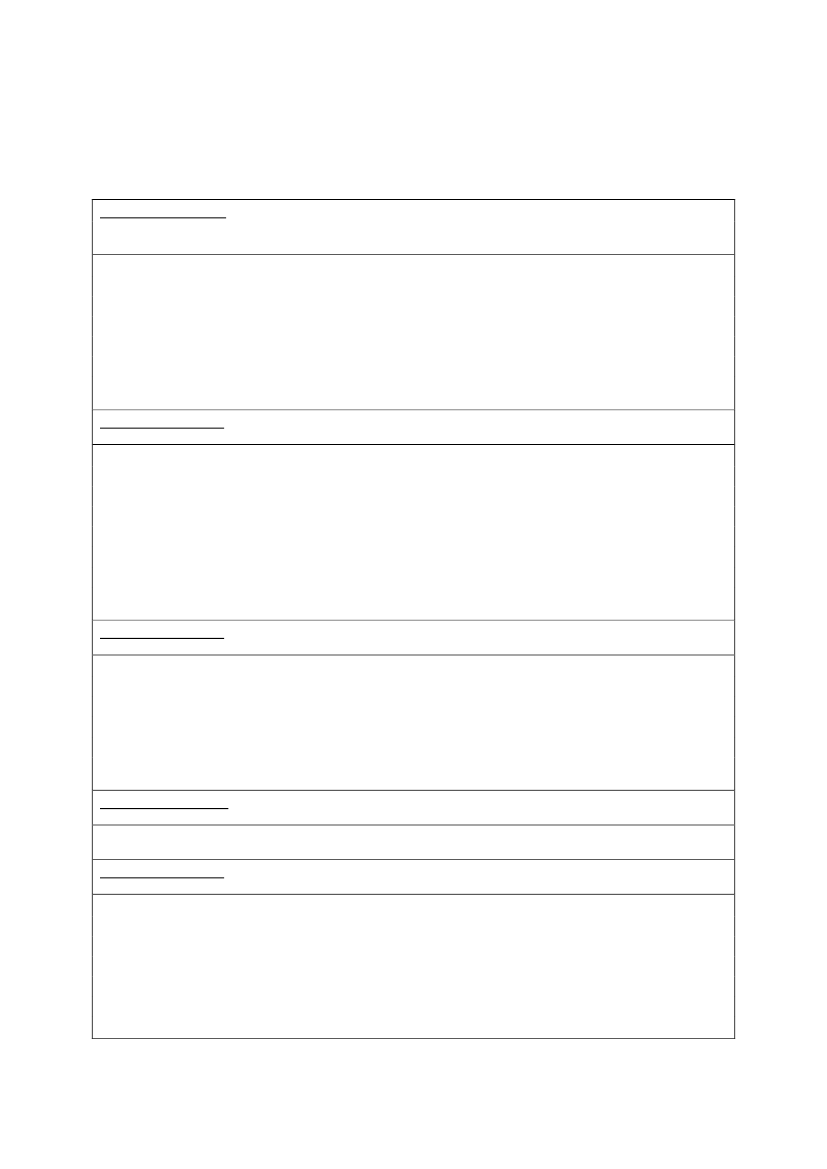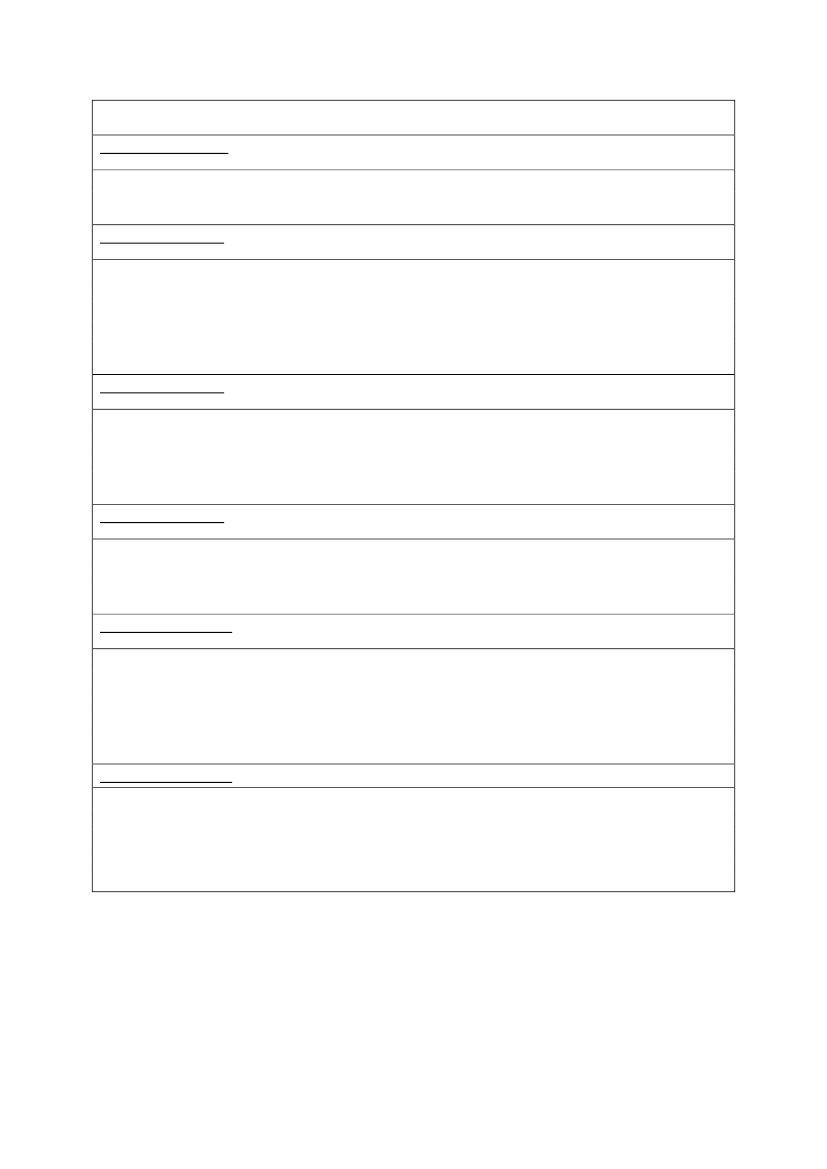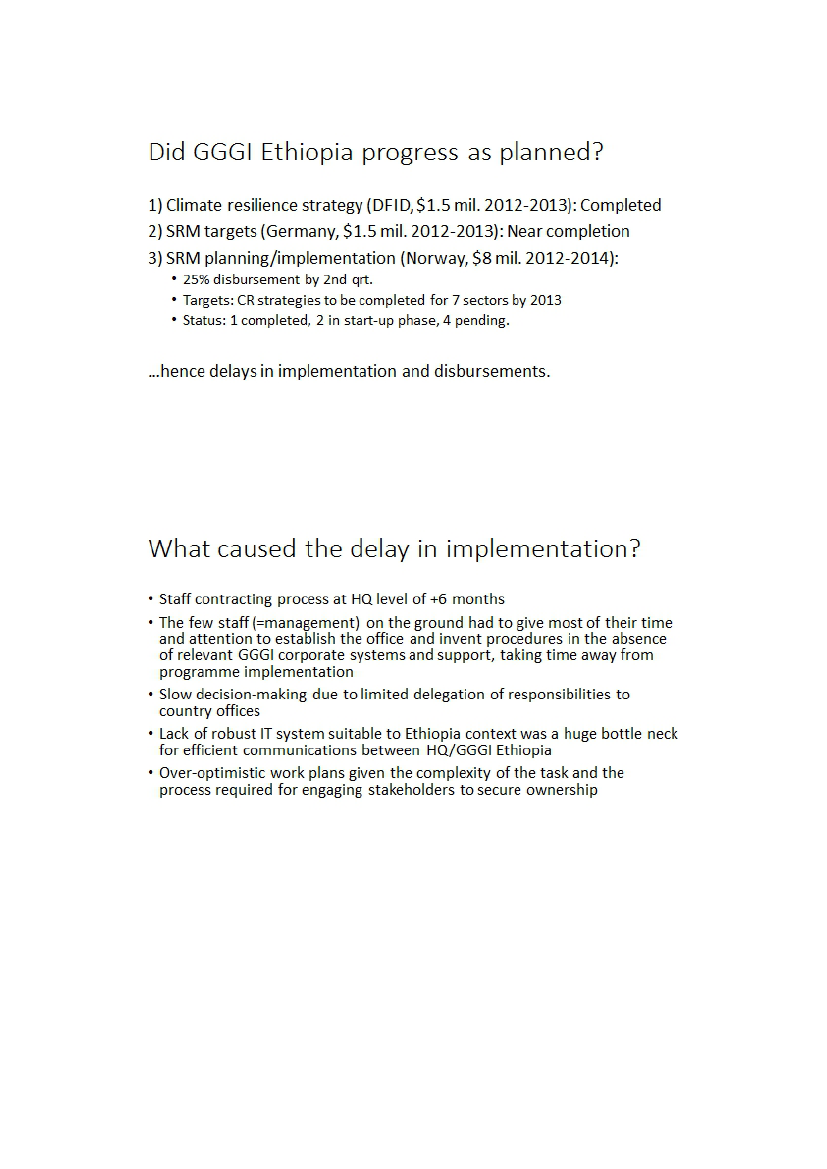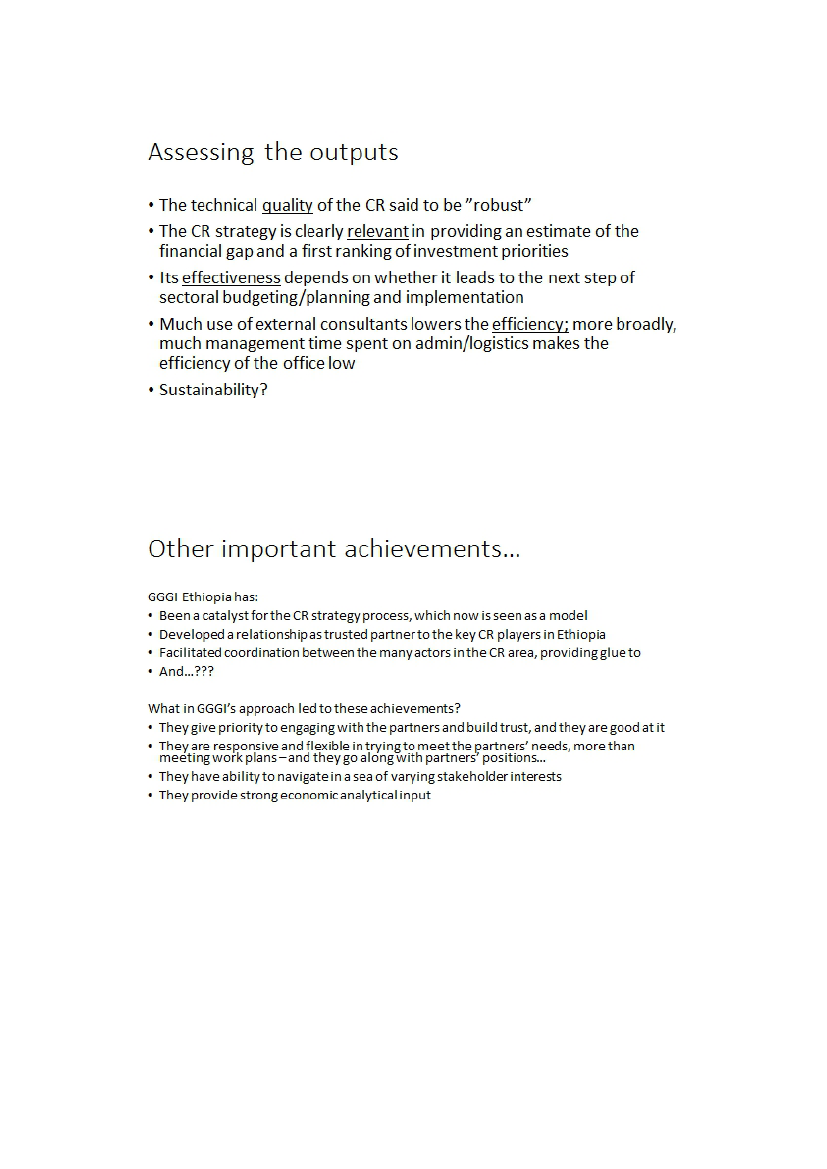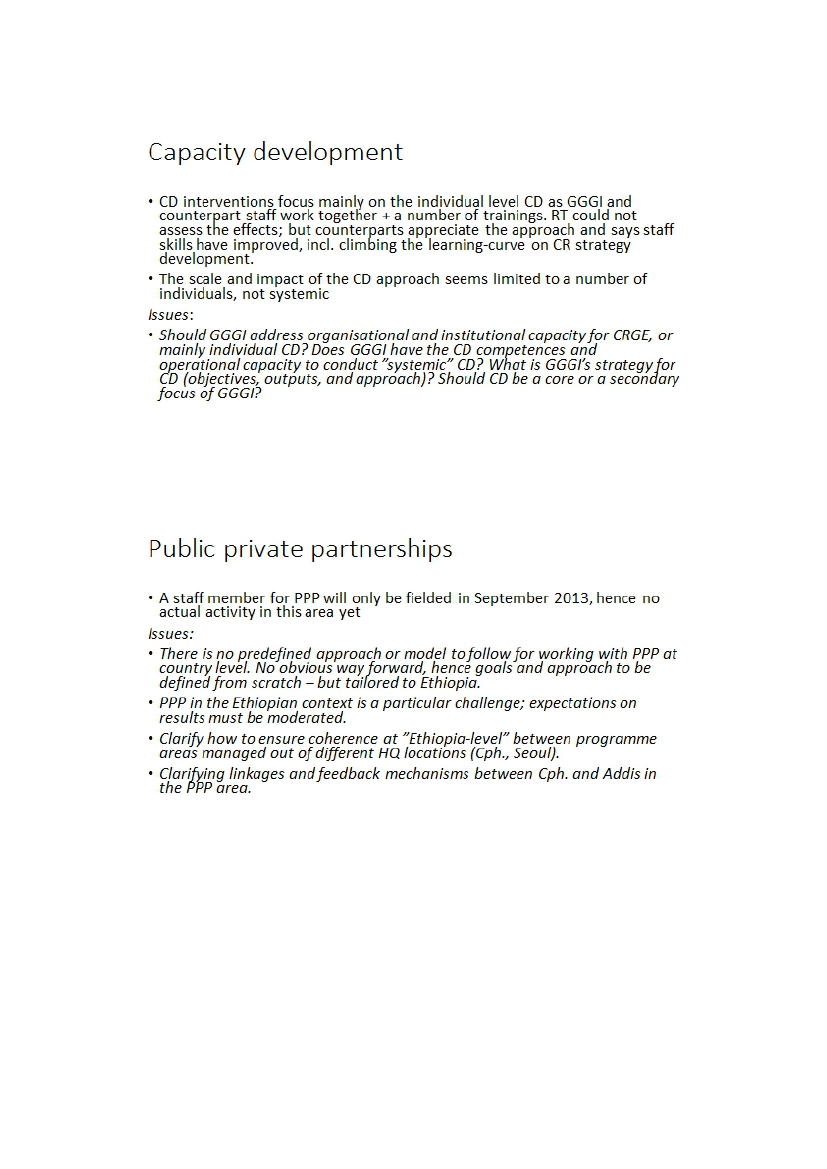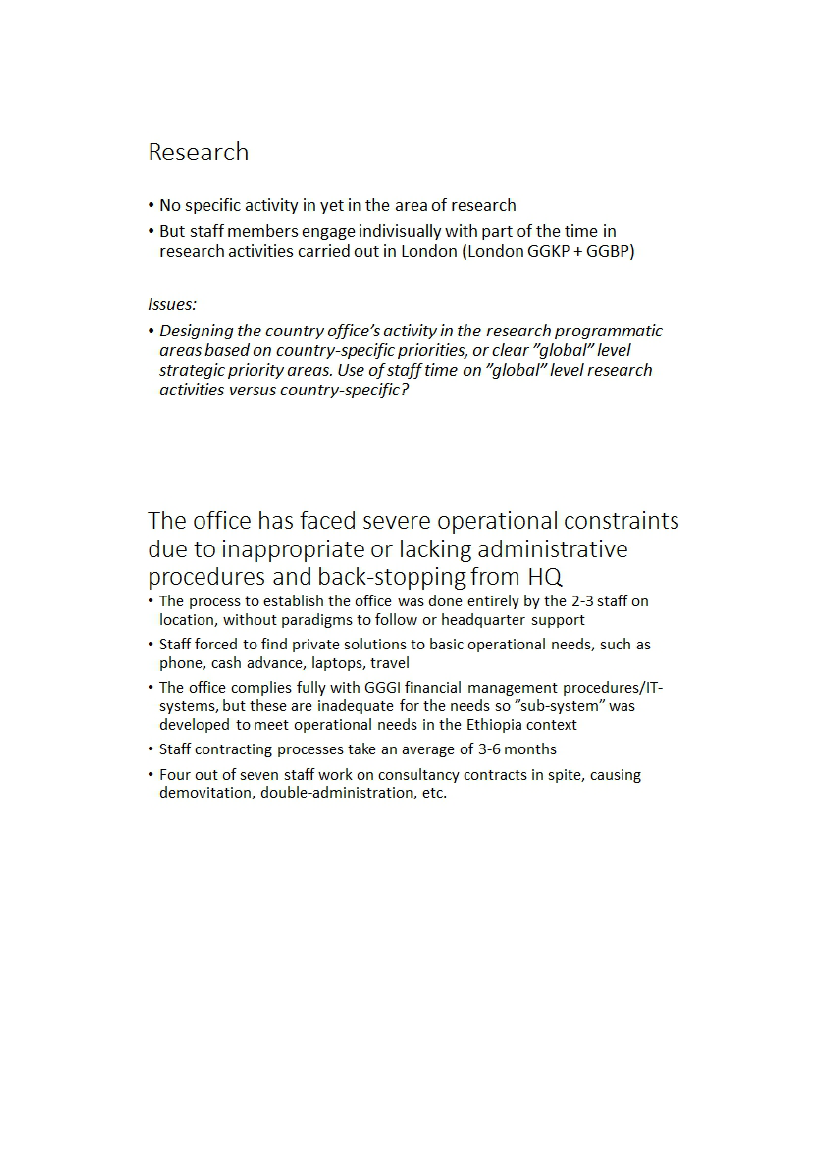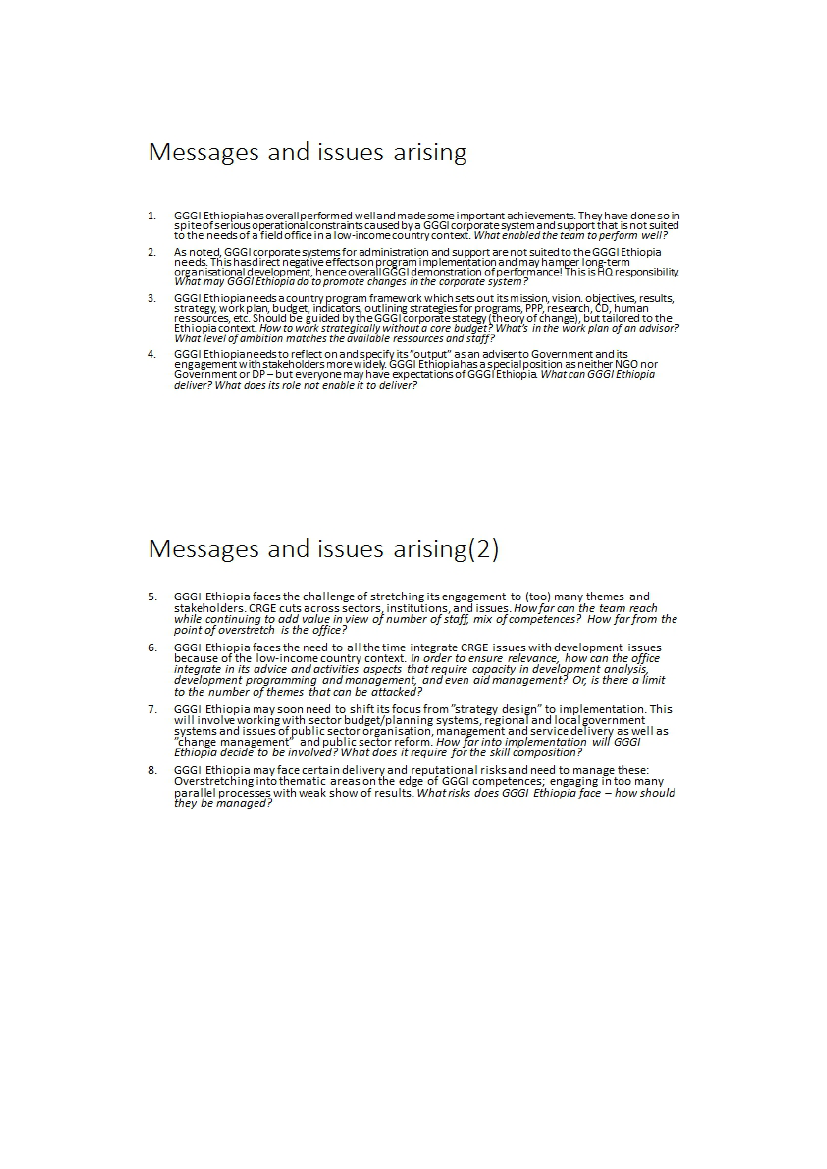Udenrigsudvalget 2013-14, Finansudvalget 2013-14, Klima-, Energi- og Bygningsudvalget 2013-14
URU Alm.del Bilag 42, FIU Alm.del Bilag 26, KEB Alm.del Bilag 74
Offentligt
4 November 2013
GGGI Management Response
Second Joint Donor Review of theGlobal Green Growth Institute 2013
GGGI management welcomes the findings and recommendations of the Joint Donor Review(JDR) performed by Australia, Denmark, Norway and Republic of Korea, September 2013(see Annex for the Second JDR Final Review Note), focused on GGGI’s cooperationprograms with developing countries. These programs are Green Growth Planning &Implementation (“GGP&I”), research (now Knowledge Development Management or“KD&M”) and public-private cooperation (“PPC”).GGGI management and staff appreciated the open and constructive discussions with thereview team during its visits to Cambodia, Ethiopia, and GGGI’s headquarters in Seoul.These provided feedback that was - and continues to be - very useful to GGGI in itscontinuing efforts to improve its systems and processes.GGGI management agrees with the conclusions and recommendations of the JDR, andrecognizes them as important inputs to both GGGI’s immediate operations and thepreparation of GGGI corporate strategy 2015-2020, expected to be proposed to Council foradoption in 2014.GGGI management has some overall observations and comments to the Review Note of 23October 2013, as well as specific responses to the recommendations and the proposed areasfor attention.
General observations and commentsThe JDR Note contains some particularly insightful observations:That GGGI is in a “double transition”, from a Korean non-government organization toan international organization, and between the previous and the new top management; andthat this double transition will continue to affect all parts of GGGI’s operations in the comingyear. GGGI management appreciates that the JDR note commends the efforts by theSecretariat to transform the operations of the organization within a short time frame. GGGImanagement confirms that the reform process remains on track. Substantial progress has beenmade in introducing approaches, processes and procedures that meet the standards of1
international government organizations. At the same time management recognizes that thetransition process remains ongoing. Management will continue to strive to improve the levelof professionalism in GGGI’s processes until members are satisfied that the organization’swork represents best practice against international organization benchmarks.Recognition of GGGI’s early achievements in partner countries, in particular thatGGGI has been successful in its objective of establishing its role as a trusted adviser togovernments, and that GGGI’s partnership approach is a key feature of its business model.GGGI management welcomes the finding that the core business model for GGGI’s countryprograms has been successful, and intends to further develop and consolidate this model.That GGGI country staff were found to be competent and dedicated, and that the JDRstressed the need for GGGI headquarters to provide more support to the country teams.Management appreciates the positive assessment of GGGI country staff, and agrees on theneed for closer contact and more support to country teams. It intends to strengthen contactthrough improved communication and information flow from headquarters to country teams.Management will also give priority to placing more qualified GGGI staff on the ground inpartner countries providing a diversified set of skills and experiences and enhancingcommunication flows.The need for better integration and consolidation of the organization’s activities.Management fully agrees with this conclusion, and is working to ensure that both the countrystrategies and the corporate strategy integrate the three GGGI work streams. This willincrease the effectiveness of GGGI’s country programs and will enable the KD&M and PPCwork streams to respond more efficiently to particular circumstances in each partner country.GGGI management agrees on the need to consolidate its operations and achievements andwill not recommend expansion into new countries for two years.The need for GGGI to intensify internal and external communication at all levels andlocalities. GGGI management sees communication as a key to achieving GGGI’s overallgoals and fully agrees to the JDR recommendations in this area. Management will continue toinvest in internal communication as an important means of strengthening corporate identityand mobilizing staff ownership and participation in the important reform processes, includingthe new strategy. GGGI management will also expand external communication activities andcrucially given GGGI’s small size, leverage support from member countries’ owncommunications endeavors. The objective will be to raise GGGI’s international profile asthe only international organization with a sole focus on green growth, to demonstrate itsadded value to collaborating countries and to clarify its niche among other internationalorganizations.
2
Responses to the JDR recommendations and proposed areas for attentionThis section presents GGGI’s responses to the 6 JDR recommendations, as well as to thespecific areas for attention on the way forward, which are proposed by the JDR team undereach recommendation.
JDR Recommendation 1The Council should assist GGGI Secretariat in coming up with a solution to the unstablefinancial situation of GGGI. The solution should not only address the immediatechallenges but also support the establishment of a long-term viable financing model.Management fully agrees that improving financial stability is critical for GGGI, including inthe short-term, and is addressing this in cooperation with member states. A resourcemobilization strategy is being prepared for discussion with the Council. It will highlightoptions to stabilize, diversity and enhance GGGI’s financial foundations. At the same time,GGGI is currently investing significant resources on strengthening systems and policiesrelated to the financial transparency and stability of the organization. A new accountingsystem will be put in place in November 2013, and an Enterprise Resource Planning (ERP)system will be introduced in 2014 allowing for real time cash balance monitoring andprojections, hence preventing unexpected cash flow issues.
Specific areas for attention on the way forward:1.1 Obtain a clear assessment of the likely financial scenarios facing the organization inthe next 1-2 years and decide on appropriate risk management measures, including aprudent approach to expanding the organization and alternative funding sources.GGGI is introducing a new accounting system to enable better cash flow analysis as a basisfor simulating financial scenarios over 1-2 years. The financial scenario analysis will helpidentify risk factors and so aid measures to prevent or mitigate risk. A spreadsheet basedmodel will complement the financial risk analysis relating to liquidity, currency andcontractual liabilities. Alternative funding sources are being examined as a way of expandingresources and mitigating emerging risks. This is to be explored in a background paper onfinancing options as part of GGGI’s resource mobilization strategy, to be discussed at theCouncil meeting in December 2013.1.2 Complete the establishment and implement more effective financial control system tobe able to provide timely and credible financial statements.The new accounting system, which records multicurrency transactions and reports them inUSD is in place and will be fully operational by the end of November 2013. This will ensurethe integrity of financial data feeding into the periodical financial report and annual financial3
statements. The financial policies and procedures, derived from the Council approvedFinancial Regulations, are being finalized for the next Council meeting in December 2013.The combination of the new policy and a new automated system will allow for more timelyand credible financial reporting.1.3 Complete the new monitoring system to be able to document results.The 2014-16 draft Work Plan and Budget includes Key Performance Indicators, milestonesand targets for all GGGI work-streams. Furthermore, GGGI will improve the currentmonitoring system by training staff on design and use of log frames and work plans forproject teams. This includes the design of appropriate indicators, including reporting onsafeguards implementation at project level. Outcomes, lessons and issues arising at theproject level are already collected through project and portfolio quarterly reports. Goingforward, final or mid-term evaluations by internal and external evaluation reviewers will beconducted in order to guarantee a transparent, independent and objective assessment ofproject outputs and outcomes. This will be developed as part of the new monitoring andevaluation system, which will be discussed with the Program Sub-Committee of the Councilin December 2013. Compliance with the reporting and financial requirements of all financingagreements will be systematically monitored. As far as reporting is concerned, GGGI willconsult with its members on the extent and level of detail required. This will be discussedwith the Donor Consultative Group, including options for donors to coordinate their reportingneeds, with a view to GGGI’s producing only one comprehensive report to all donors. Thenew strategic plan for 2015-2020 will include a comprehensive monitoring, review andevaluation framework.1.4 Implement anti-corruption measures at all levels of the organization.The anti-corruption policy has been developed by management to ensure at all times theintegrity of donor funds. This policy is complementary to the whistle-blower policy and otherinternal control policies and procedures, as specified under the Council approved FinancialRegulations.Management will implement the new anti-corruption policy along with other actions -including procurement rules, approved by the Council and now enforced – that comply withthe highest standards required by international organizations. Staff is bound by a code ofconduct covering ethics and business practices. Communication and training on thesemeasures will be provided to GGGI personnel, as well as external parties associated withGGGI, such as consultants and vendors. In addition, the Office of Internal Audit andIntegrity (OIAI) will conduct independent monitoring and evaluation of the anti-corruptionmeasures implemented by GGGI management.
4
JDR Recommendation 2Throughout the coming year, the operations of GGGI are likely to be characterized bycontinued reform of the organization and procedures and by the development andoperationalization of the new strategy. During this period, GGGI should limit its expansioninto new countries and focus on consolidation and professionalization. The scale andspeed of expansion, including the staff profile, should be in line with the overall strategyand prioritization of effort and lessons learned. Consolidation at headquarters on keyfunctions on all three pillars is particularly important.GGGI management agrees with the JDR recommendation for consolidation andprofessionalization. GGGI expanded rapidly in 2012 and 2013 in order to meet the needs ofpartner countries and to accomplish the organization’s goals. In 2014, GGGI will not expandits operations in partner countries and will increase staff only in order to have a stronger in-country presence and to replace some of the work that until now has been outsourced.Additional staff will also be required to strengthen in-house capabilities in management andadministration and in the three work streams, consistent with the overall strategy of greaterintegration. In the coming year, management will complete the building of strongercapacity across all three work streams.Specific areas for attention on the way forward:2.1 Reduce the pace of the expansion in staff until a clear strategy and mapping ofcompetence requirements is in place (see below).Staffing for the next 2 years will follow a gradual expansion, with a focus on consolidation ofin-house expertise and in-country presence of country teams. Currently, there is no plannedexpansion in terms of country program for 2014, and a limited expansion of staff linked toprecise competence requirements as GGGI continues replacing external consultants withinternal capacity across operations. Some additional staff will also be required to strengthenmanagement and administration capabilities. (See also section 4.1 below.) Future recruitmentwill be aligned with the overall objectives and expected outcomes in the new 2015-2020GGGI strategy.2.2 Give high priority to communicating to all levels and localities of GGGI regarding theaims, focus, changes, timing and status of the ongoing reforms of the organization and itsprocedures.GGGI management will continue to be proactive in communicating the reform agenda to allparts of the organization. Specific communication plans are developed for each of the majorreform activities. Practically, each work stream is currently holding regular all staffmeetings across GGGI’s locations as well as inter-department meetings to strengthenintegration across work streams. All new policies, regulations, procedures, and systems are
5
now communicated to staff through direct emails and through a weekly internal newsletter.Management will improve public communication in these areas as well.2.3 Be careful not to over-shoot on the new organizational architecture.GGGI management recognizes the risk for GGGI, as a small but ambitious internationalorganization, to becoming overly bureaucratic and inflexible, and thus reducing its ability torespond to the needs of its clients and stakeholders. To address this, management remainscommitted to a results-based approach, and to establishing internal rules, procedures andclear delegation of authority that allow the organization to remain nimble. The Secretariatwill continue to balance the needs of a new international organization and the available staffresources. The new organizational structure will be reviewed in early 2014 to ensure that itcontinues be appropriate.2.4 Build a strong “core” organization in Seoul for all three pillars and revisit the staffratio between HQ/hubs vis-à-vis country teams, and aim at a higher staff ratio in-country.The current plans for 2014-2016 include the strengthening the KD&M (research) and PPCwork streams in Seoul, thus completing the building of a strong core for all three workstreams at headquarters. A priority is to strengthen GGGI’s presence in the partner countriesto allow for a more effective ‘embedding’ of staff in partner governments. This will increasethe proportion of staff located in partner countries and will be the most effective way toensure that GGGI becomes, over time, a long-term ‘trusted partner’ of our partnergovernments.2.5 Limit the total number of partner countries to approximately 20 until 2015.The current work program for 2014-16, submitted to the Council for approval, confirms thatthe priority is consolidation and focus and that the number of partner countries will be limitedto the current 20.
JDR Recommendation 3In the future, GGGI identity and strategy have to be owned and consistently interpreted inthe same way by all staff, management and governing bodies no matter their physicallocation and daily tasks. For this to materialize, the upcoming strategy process should beforward-looking, realistic, and inclusive, and built on lessons learnt and the origins ofGGGI, as well as input from new staff and external stakeholders. The strategy should besufficiently detailed and well thought through to guide the scoping of GGGI projects -without becoming a straightjacket. Internal communication and transparency will be keyto its success. GGGI needs to have a clear understanding and definition of its core andnon-core activities.
6
GGGI is forming its organizational identity. This is being done, in part, by formulating anew 2015-2020 strategic plan through a “bottom up” process that gives buy-in to all levels ofthe organization. This will include integrating the three work streams as well as increasingthe volume and quality of both external and internal communications in order to ensureGGGI is projecting a consistent message externally and reinforcing a cohesive identityinternally. The strategy will be based on GGGI’s comparative advantages and its ability todeliver realistic results within specified timeframes. It will be informed by GGGI’sexperience so far, including the achievements and continuing challenges faced by theorganization. The strategy will be the main guiding document to develop future programs andprojects in order to ensure results delivered at the country level are aligned to GGGI’s visionand overall objectives.
Specific areas for attention on the way forward:3.1 Ensure involvement and lessons from GGP&I, research and PPC staff across theorganization, at central and country level, in the development of the new strategy and inthe programming guidance. Allow time for discussion.The 2015-2020 strategic plan formulation process is based on a “bottom up” approach. Acore team for each work stream will be established on a representative basis. Priority-settingacross work-streams will take place in sequential steps: (i) a stakeholder analysis-includingcountry and headquarters team members, donor countries as well as partner countries; (ii) asituation analysis of the countries/regions where GGGI is active (iii) option analysis. Eachwork stream will ensure that priorities are translated into a manageable set of results –outcomes and outputs – that describe the strategic focus and how those results will contributeto GGGI global goals. Three further steps will complete the initial process: (i) ResultsFormulation (ii) Assumption and Risk Analysis (iii) Monitoring and Evaluation Frameworkdesign. This process will be carried out over a 3 month period of extensive consultation bythe core teams with country and headquarters staff.3.2 Clarify and communicate the integration between the GGP&I, research and PPCpillars, based on what is realistically possible and what effectively contributes to GGGI´smission of promoting the implementation of green growth in the partner countries.GGGI management gives high priority to integrating the three work streams. All work-streams will ultimately contribute to strengthening in-country analytical and planningactivity, the main output of GGGI’s work. The integration has already been strengthened:preparation of the Work Plan and Budget 2014-16, which commenced in September 2013,included setting integrated activities from PPC and KD&M in the country programs, and viceversa. This resulted in cross budget allocations which will lead to much closer integration ofall three work streams. The KD&M and PPC work streams will be increasingly aligned withthe needs and lessons from country programs; responding to the needs of partnergovernments and playing a key role both in sharing lessons among GGGI country programsand in feeding into the international Green Growth research agenda.7
3.3 Strike the balance between GGGI’s spirit of entrepreneurship and capacity to beresponsive to emerging priorities and opportunities, and the need for project planning,accountability frameworks and decision-making structures.GGGI management will continue to promote balance in policy development between creatingan entrepreneurial frame and the need for accountability and appropriate controls. GGGI isembedding the core project planning, selection, accountability and decision-makingstructures necessary for a robust, transparent and effective international organization.However, GGGI management also recognizes the need to balance these with a continuedcapacity to be flexible and responsive to the windows of opportunity in the local greentransformation processes, and to cultivate a spirit of entrepreneurship amongst its staff.Management will place priority on embedding this balanced perspective in the emergingorganizational culture.3.4 Clarify and communicate across the organization guidance on programming steps anddefinitions linked to GGGI’s scoping and implementation stages, including ways tobalance quick-wins with progress on long-term goals.GGGI is in the process of developing a project “gateway” procedure. The procedure willinclude step-by-step guidance from conceptualizing a project to its final approval and willdetail a balanced set of criteria that a project must meet to move from scoping toimplementation stages. Appraisal criteria, among others, will include each project’s potentialimpact on the short- and long-term objectives of GGGI, its feasibility, desirability and costeffectiveness as well as its potential value for money.In addition, the Core Operating Processes (COP) documents are being revised and willinclude clearer definitions of objectives, programming steps and the scoping andimplementation stages. This will allow for a more precise shared understanding of the keycomponents that projects must incorporate at each stage, and a better balance between shortand long term goals.3.5 Ensure external communication to explain GGGI’s work and value-added to externalstakeholders and take a proactive and open approach to connect with other green growthinitiatives and programs globally and in the partner countries.GGGI management will work with member governments to improve public communicationof its activities. While the organization is proposing increased capacity for communicationswork in its draft Work Plan and Budget, the small size of the Secretariat means that it mustalso rely on assistance from members. The objectives of this coordinated campaign will be toraise its international profile, to demonstrate the added value of GGGI’s work to partnercountries, and to clarify its distinctiveness among other international organizations.GGGI will continue to scale up its external communication efforts through its website,including more content about the organization's activities, in particular its country8
experiences, and will produce more informational material to distribute to member countriesand the public. This includes producing project-specific brochures, pamphlets and briefs aswell as distributing a regular organizational update to member and signatory states. In 2014,GGGI will produce a more comprehensive set of publications, including a number of policypapers and briefs.GGGI seeks to conduct global public relations outreach by working with a global reportingservice to facilitate and strengthen partnerships with media outlets, press correspondents, andprivate and public institutions. In 2014 GGGI will cooperate with a Korean news agency todisseminate information to the host country audience. GGGI will also be more active throughsocial media, such as Twitter and Facebook.GGGI will continue to raise its international profile, through engagement with initiatives suchas the Green Growth Knowledge Platform and the Green Growth Best Practices Initiative,and through organizing and participating in relevant workshops and conferences. GGGImanagement will use this as a platform for providing focused inputs to importantinternational processes, including the post 2015 development goals.
JDR Recommendation 4The core of GGGI’s work is support to green transformation globally and at country level.Green transformation is by nature long term and highly political. In addition to havingstrong subject matter competences, all GGGI staff needs competences in changemanagement, political economy, environmental management and developmentcooperation.During 2013, GGGI recruited experienced experts in the field of development from otherinternational organizations and development agencies within governments. This trend willcontinue in 2014. In addition, GGGI is undergoing a process of strengthening its in-countrypresence in which GGGI experts are dispatched to partner countries and embedded inrelevant ministries and agencies in place of consultants. In order to strengthen competenciesamong staff, GGGI is intensifying training in the areas relevant to their functions.Headquarters staff with specific expertise not available in every country will travel asrequired to country projects, with the aim to strengthen contact, improve communication, andgain better understanding of both progress and challenges. Such visits will also contribute tocapacity building among country teams. GGGI management agrees with the JDR team thatstaff should have competencies in issues such as change management, political economy anddevelopment cooperation, and will make this a priority in future recruitment.
9
Specific areas for attention on the way forward:4.1 Use a strategic approach to guide the in-take of new staff during 2013/15, based onassessment of the skills and competences needed across the organization in order toimplement the new strategic framework and be able to respond to partner country needsand context. Prioritize a multi-disciplinary staff composition profile.Recruitment during 2013 has brought into the organization a number of experienced seniorpractitioners from the development arena. GGGI management will recruit new staff with aparticular attention to competences relevant to the new strategy, including in areas such aschange management, political economy and development. This will be reflected in a staffingand recruitment plan which will be developed and implemented from 2014 with the followingelements: analyze training needs; map required job competencies; identify available skills ofstaff; define the competencies plan; and set out recruitment priorities. In the plan specialattention will be given to ensuring gender and geographical balance as well as diversity ofskills.4.2 Take all necessary and possible measures to enable more staff to be placed in thepartner countries.Strengthening the in-country presence within the country projects and programs has been apriority from early 2013. This has already led to the expansion of several in-country teams. Inresponse to the JDR, a decentralization strategy is being developed in consultation with staff,and will be put in operations from Q1 2014. GGGI aims at concluding the process ofdecentralization in the coming 12 to 18 months.In parallel and as a high priority, GGGI is pursuing negotiation of a Privileges andImmunities Agreement among its member states, and Host Country Agreements with thosecountries with a significant GGGI presence. Through this, GGGI will have increasing abilityand flexibility to place international staff in partner countries.4.3 Upgrade the focus on assumptions and risks in the planning and monitoring of countrylevel activities reflecting the nature of local green transformation processes.GGGI will intensify training on log frames which will include the correct formulation ofassumptions and risks at all project levels, including the risks associated with ensuringcontinued political support to a green growth transformation from partner countries. Thecurrent risk management responses by the project teams is monitored on a quarterly basis.Risk management will be further improved by the strengthening of GGGI’s local presence inthe countries.
10
JDR Recommendation 5GGGI’s country programs need to be more selective and realistic, particularly during theirimplementation phase. Country programs should have a clear strategic focus, drawing onparticipation at the local level through cooperation with stakeholders at the local andnational level. GGGI’s new strategy should promote transparency towards local partners,consultations across government ministries and other civil society actors, collaborationwith similar initiatives/ programs, and a two-way sharing of knowledge, experience andinformation in country and between GGGI partner countries.GGGI management recognizes the need to further clarify the frameworks and accountabilityfor activities in partner countries through developing clear and realistic country strategies.Country strategies for the period 2014-16 have now been drafted and will be finalized overthe coming months. These will ensure stronger strategic focus and alignment to the 2015-2020 strategy and to national policies and plans. The strategies are being developed in closecooperation with the government counterparts and other stakeholders, to ensure full co-ownership and transparency. They specify capacity development goals and initiatives andperformance indicators together with milestones and targets, and include knowledge-sharingactivities among government, development partners and non-state actors.Specific areas for attention on the way forward:5.1 Clarify GGGI’s special niche and value-added at partner country level and ensure thatthe attention and resources of country teams and the HQ backstopping efforts target theseareas.Many organizations are active internationally in promoting sustainable development in itswidest meaning. Green growth is a part of that and is generally described as a means ofachieving sustainability, with an emphasis on low carbon development in recognition of thesalience of climate change among global challenges. GGGI’s distinctive position – its niche -is characterized by a combination of several unusual features. First it is focused on economicgrowth – on broad economic development with objectives set by partner governments.Second, it comes with noa prioriagenda for aspects of the green growth path - these are theproducts of analysis of the circumstances of the individual countries concerned. Finally it hasno investment funds. This latter may appear to be a serious disadvantage given that so manyother organizations undertake analysis as a precursor to investing but for GGGI, it has theadvantage of lending independence and credibility to its analysis.These features in combination create the distinctive capacity for GGGI to become a trustedadviser to partner countries. This is underpinned by focus on analysis and planning to achievethe government's national development objectives accompanied by a readiness to engage in aconstructive dialogue with stakeholders, including civil society organizations and the privatesector. Investing in a strong local presence and ensuring the highest possible quality ofinsights and analysis are critical success factors. Improved capacity, including at11
headquarters, to take full account of the political economies of partner countries (seereferences in the response to Recommendation 4) will enhance the utility to partners of theorganization’s work. The rapid development of the monitoring and evaluation frameworkreferred to earlier will ensure quality control of outputs.
JDR Recommendation 6A new joint donor review should take place no later than in 2015. Consideration shouldbe given to the inclusion of non-donor members in the next review process, potentiallydrawn from GGGI council’s program sub-committee.GGGI management welcomes the suggestion for a further joint donor review, including thesuggestion to include non-donor members. GGGI management sees an important role for theProgram Sub Committee and GGGI’s Donor Consultative group in the planning of the nextjoint donor review.
12
ANNEX
Second Joint Donor Review of the Global Green Growth Institute2-13 September 2013
Final Review Note
23 October 2013
Australian Agency for International Development, AusAIDKorean International Cooperation Agency, KOICAMinistry of Foreign Affairs, Denmark, DanidaNorwegian Agency for Development Cooperation, Norad
Table of contentTable of content ...................................................................................................................................... 1Acronyms ................................................................................................................................................ 21.2.3.4.56.Introduction .................................................................................................................................... 4Assessment of GGGI programs at country level ............................................................................. 5GGGI strategic framework and corporate systems....................................................................... 14Governance and partnership frameworks .................................................................................... 27Follow-up to the 2011 inception review ....................................................................................... 29Conclusions and recommendations .............................................................................................. 29
Annex 1: Status of follow-up to the 2011 review recommendations ................................................... 34Annex 2: Terms of Reference for the review ........................................................................................ 36Annex 3: Debrief of GGGI Cambodia country program held in Cambodia ........................................... 40Annex 4: Debrief of GGGI Ethiopia country program held in Ethiopia ................................................ 45Annex 5: Debrief of GGGI Cambodia country program held at headquarters ..................................... 52Annex 6: Debrief of GGGI Ethiopia country program held at headquarters ........................................ 57Annex 7: List of people and institutions met in Cambodia ................................................................... 61Annex 8: List of people and institutions met in Ethiopia ...................................................................... 63Annex 9: List of people met at headquarters ....................................................................................... 65
1
AcronymsAusAIDCSIROCOPCRCSRCRGEDanidaDFIDDGDSCEACPEMGGGGGBPGGGFGGGIGGKPGGP&IGSGGHQHRMIOISACJDRK-GGGIKLRIKOICALDCAustralian Agency for International DevelopmentAustralian Commonwealth Scientific andIndustrial Research OrganisationCore Operating ProcessClimate ResilienceCooperate Social ResponsibilityClimate Resilient Green EconomyDanish international development assistanceDepartment for International Development, UKDirector GeneralDonor Consultative GroupKorean East Asia Climate PartnershipGGGI’s Executive Management GroupGreen GrowthGreen Growth Best PracticesGlobal Green Growth ForumGlobal Green Growth InstituteGreen Growth Knowledge PlatformGreen Growth Planning & ImplementationGeneral Secretariat on Green Growththe GGGI headquartersHuman resources managementInternational OrganizationIntegrated Solutions Asia CooperationJoint Donor ReviewKorean GGGI (GGGI before becoming an IO)Korea Legislation Research InstituteKorean International Cooperation AgencyLeast Developed Countries
2
LSEM&EMEPFMoEMoUMTPNCGGNGONoradNPGGNSPGGODAOECDPPCPPPPWBQIRSRMTORUNUNIDOUNDP
London School of EconomicsMonitoring and EvaluationMinistry for Environmental Protection and ForestMinistry of EnvironmentMemorandum of UnderstandingMedium Term PlanNational Council on Green GrowthNon Governmental OrganizationNorwegian Agency for Development CooperationNational Policy on Green GrowthNational Strategic Plan on Green Growth 2013-2030Overseas Development AssistanceOrganization for Economic Cooperation andDevelopmentPublic-Private sector CooperationPublic Private PartnershipProgram of Work and BudgetQuarterly Implementation ReportsSector Reduction MechanismTerms of ReferencesUnited NationsUnited Nations Industrial DevelopmentOrganizationUnited Nations Development Programme
3
1. IntroductionThis review note presents the findings and conclusions of the 2013 Joint-Donor review (JDR)of the Global Green Growth Institute (GGGI), an interdisciplinary, multi-stakeholderinternational organization, dedicated to pioneering "green growth" involving a simultaneousfocus on economic performance, environmental sustainability and social inclusion inemerging and developing countries.GGGI’s major activity area is the Green Growth Planning & Implementation (GGP&I) pillarwhich aims to provide analytical and institutional support to partner countries within thecontext of their own development policies and strategies, with a focus on green growthanalysis and planning, capacity building and public-private partnerships to support theimplementation of their green growth policies. The GGP&I pillar is supported by pillars inresearch and public-private sector cooperation (PPC).Australia and Denmark undertook a joint inception review of the GGGI in November 2011.In agreement with the GGGI, this focused mainly on the institutional challenges facing theGGGI as a new institution. The review suggested that Australia and Denmark shouldorganize a joint review in 2013.The objective of the present 2013 JDR was primarily to assess the progress of the GGGI’sGGP&I programs in developing countries, though the program related aspects of research,PPC operations, GGGI’s governance structures and partnership behaviors were alsoreviewed, in relation to the GGP&I program (see Annex 1 for Terms of Reference).The JDR team had representatives from Australia (AusAID), Denmark (Ministry of ForeignAffairs/Danida), Norway (Norad) and the Republic of Korea (KOICA) for a two-week review(2-13 September 2013).1In the first week, the JDR team divided itself and visited the GGP&Icountry programs in Cambodia and Ethiopia, and discussed the GGGI’s program with theGGGI staff and consultants and key partners, including relevant ministries, civil societyorganizations and the private sector (in the case of Cambodia), UN agencies, and otherdonor agencies. Field visits were also organized to GGGI pilot activities or other relevantGreen Growth (GG) projects. A debrief was held with the country teams on the final day ofthe country visits (see the annexes for debriefs and lists of people met).The second week of meetings was held at the GGGI headquarters (HQ) in Seoul, Republic ofKorea, with the full JDR team. Debriefs were given from the country visits and meetingswere held with key staff at HQ. A final debrief was presented to the GGGI’s senior1
The JDR team consisted of: Anette Aarestrup (Team leader), Danish Ministry of Foreign Affairs/Danida, LaurenC. Naville Gisnås, Norad; Fiona Lord, AusAID; Keun-sik Han, KOICA; Diane Yeon Joo Suh, Danish Embassy, Seoul;Thomas Juel Thomsen, Consultant. In addition, Sue Moore/AusAID and Lars Ekman/Norad – both based inAddis Ababa participated in Ethiopia and John Ward, Australian Commonwealth Scientific and IndustrialResearch Organisation (CSIRO) participated in Cambodia under the AusAID-CSIRO Alliance.
4
management team, containing the five main conclusions and five main recommendationsalso presented in this note. The final JDR review note takes into account remarks madeduring the final debrief.From the discussions at GGGI HQ, it was immediately apparent that the entire organizationis in the early stage of a double transition, from a Korean non-governmental foundation toan international organization, and from practices associated with a previous leadership tonew systems and ways of working implemented by a new leadership team. It was also clearthat many of the JDR team’s findings from the first week regarding the country programsreflected the previous systems and management approach, which the new leadership iscurrently working to fundamentally change. Therefore, it was decided that rather thanfocusing the review on assessing the progress of a previous strategy and organization, tofocus instead on documenting the current situation at country level, and transmit thelessons into the strategy discussions at HQ, and on this basis, review the strategy andorganizational adjustments considered by the HQ. The review note is therefore organized inline with this approach.It should be noted that since the purpose of the country visits was to inform the assessmentof the overall GGP&I pillar, no in-depth review was made of each of the two countryprograms – this would not have been possible given the limited time in-country. Also, whilethe review team received a large amount of new GGGI strategy documentation, most wasreceived just before or during the visits to headquarters, which means it was not possible toreview these documents in-depth. However, general reference will be made to thedocumentation where relevant.In line with the outlined approach, section 2 of this note presents the findings on the statusof results and issues arising in the implementation of the GGP&I programs at the countrylevel. On this basis, section 3 assesses the strategic, organizational, and managementresponses by GGGI HQ to the current situation at country level. Section 4 assesses GGGI’sgovernance structures and partnership behaviors. Section 5 presents a status update on thefollow-up to the 2011 review recommendations, while section 6 presents the conclusionsand recommendations.The JDR team would like to thank all GGGI staff and counterparts in Ethiopia, Cambodia, andSeoul for their open and frank discussions as well as for the immense effort in organizing thereview and arranging logistics and meetings for the teams.
2. Assessment of GGGI programs at country levelGGP&I activities were initiated in Ethiopia in 2010 with support from Korea (KOICA: USD 1.2million). The current GGP&I activities in Ethiopia consist of a set of three bilaterallyearmarked funded projects (DFID: USD 1.5 million, Germany BMU: USD 1.5 million, andNorway: USD 8 million). There is no country strategy outlining a single set of overarching5
strategic objectives and outputsthat GGGI aims to achieve in Ethiopia.2Since September2013, GGGI Ethiopia has 8 full time staff and “GGGI consultants”, including one in London(staff grew from 3 staff in 2012 and 5 in May 2013). GGGI’s Ethiopia office considers theiractivities to be in the scoping stage of the programmatic cycle, given that most work so farhas focused on input to establishing strategies, mechanisms and processes to beimplemented by the Ethiopian Government counterparts in the coming period.The GGGI Cambodia program was initiated in March 2011 with a MoU between GGGI andthe Royal Government of Cambodia. The Cambodia program completed its first phase of‘scoping and design’ in early 2013. The total budget of GGP&I Cambodia since 2011 isUSD2.3 million. The Korean East Asia Climate Partnership (EACP) funded the first phase ofthe Cambodia program (until March 2013), and activities in Cambodia are currentlysupported by GGGI’s core funding (USD 1,243,559 in 2013). The Cambodia team is currentlyre-designing its GGP&I activities under a new strategy (first draft in August 2013). GGGICambodia has 2.3 full time staff based in Seoul, and 3 local consultants in Phnom Penh. It iscurrently unclear as to whether the phase two of GGP&I in Cambodia will become a groupof ‘projects’ or graduate to become a ‘program’ with increased annual funding.In both countries, activities were defined by the country teams, exploitingwindows ofopportunitypresented by the governments’ interests and priorities, country-level donorinterests, and the GGGI country team’s judgment of what may take the green growthagenda forward in the context. In spite of an absent overarching strategy, the countryprogram/projects were in line withGGGI’s core missionand, importantly, their outputsreflect the two governments’ priorities. Box 2.1.a sums up the country-level objectives andmain intervention areas for the two case-countries, Cambodia and Ethiopia, as well as anindication of the initial results.Box 2.1.a. Summary of GGP&I objectives and indicative results – Cambodia and EthiopiaGGP&I objectives for Cambodia…GGGI aims to assist the Government of Cambodia in the following ways:Establishing institutional and legal frameworks for implementing green growthMainstreaming green growth in the national development agenda and relatedstrategiesProviding sectoral and thematic green growth solutions based on analysis, andmobilizing resources for implementationEngaging the private sector in consultation and implementation processes ofgreen growth policies.3
…. Positive initial achievements in Cambodia2
Although the Ethiopia Masterdeck notes ‘GGGI Ethiopia has an integrated program of activities’ – these areseparately managed bilateral donor activities, with three separate COP design documents.3‘Shapingthe Future with Green Growth’– presentation by Joosueb Joseph Lee, GGP&I, GGGI – consultationwith the National Council on Green Growth, Phnom Penh, Cambodia, 2 September 2013.
6
GGGI has contributed to the formation of key policies and institutional frameworks forgreen growth in Cambodia. GGGI has assisted with the coordination of the Government ofCambodia’s line agencies in the formation of a national policy and strategic green growthplan and provided technical advice on green growth in a range of areas. Keyachievements of the Cambodian Government, supported by the GGGI to date, include:The 2012 establishment of theNational Council on Green Growth(NCGG), officiallylaunched in March 2013, with the Prime Minister appointed as the first HonoraryChairperson. The Council is designed to act as an arena for inter-ministerialdiscussion and consensus-sharing among ministries.The establishment of theGeneral Secretariat on Green Growth(GSGG) in 2012,which is the implementing organ of the NCGG. The GSGG is an inter-ministerialbody, which is essential for Cambodia achieving its green growth ambitions.The establishment of theNational Policy on Green Growth(NPGG) and theNational Strategic Plan on Green Growth 2013-2030(NSPGG) with support of thePrime Minister, H.E. Samdech Hun Sen, in March 2013.
In parallel, GGGI has also supported public-private cooperation in Cambodia at a local-level in Takeo province, through pilot activities and business incubation. In Takeoprovince, GGGI has supported the uptake of solar technologies through an AppropriateTechnology Centre, in partnership with EcoSolar (a commercial spin-off of the CambodianNGO ISAC). GGGI has helped to develop solar products and provide training support tostudents seeking to sell the solar products. Products include solar home systems,household solar cookers and community (Sheffler Reflector) solar cookers.GGP&I objectives in Ethiopia…GGGI Ethiopia has the overarching aim of enabling an economic transformation inEthiopia for a green and climate resilient future, through three objectives:1.To enable a pathway to green growth.GGGI Ethiopia is working to support theEthiopian Government’s efforts to put in place a strategic framework forresponding to climate change. This includes a national strategy and a mechanismfor reducing emissions and vulnerability.2.To build national capacity.GGGI Ethiopia aims to build the capacity of its partnersin Ethiopia to develop and implement climate change and green growth policy.This includes the capacity of government, civil society and the private sector.3.To build partnerships and share knowledge.GGGI Ethiopia aims to establisheffective partnerships with a range of partners. GGGI will use these partnershipsto deliver the above objectives in a coordinated way and to share experiences withstakeholders both within and outside Ethiopia.4…. Positive initial achievements in EthiopiaGGGI is assisting the Government of Ethiopia with the formulation and implementation ofEthiopia’s Climate Resilient Green Economy (CRGE) Strategy. Under the CRGE strategy,4
GGGI Ethiopia Master Deck, updated July 2013 – noting there is not a strategy document per se for thecollective management of the three separately managed bilateral donor activities.
7
Ethiopia aims to achieve middle-income status by 2025 through zero net carbon growth.The CRGE strategy covers a range of sectors including agriculture, forestry, water, energygeneration, transport, industry and buildings. GGGI Ethiopia has helped to facilitatecoordination between key actors in the green growth arena, and provides in-housecapacity building assistance on the CRGE strategy. The achievements to date include:With funding from the United Kingdom, GGGI has supported the EthiopianGovernment to develop the Climate Resilience (CR) Strategy for Agriculture of theCRGE Initiative, which is expected to be published later in 2013.With funding from Germany and in partnership with the Ministry for EnvironmentalProtection and Forest (MEPF), GGGI is supporting the design and implementation ofthe Sectoral Reduction Mechanism (SRM), supporting the planning pillar of the MEPFprocess. This involves identifying targets and baselines for emissions and vulnerabilityreductions for each sector in Ethiopia’s economy.With funding from Norway, GGGI is assisting with the remaining elements of thedesign and implementation of the SRM, including the analysis and planning pillar at asector level, the coordination pillar, the measuring, reporting and verification pillar,the finance pillar and the knowledge management pillar. Under the finance pillar inparticular, GGGI is working with Ethiopia’s Ministry of Finance and EconomicDevelopment to establish a funding facility for implementation of the CRGE.
A key finding of the review is that the two country teams have delivered a number ofimportantachievements and early results.While both programs are still at an early stage,the country teams have adopted a focus and approach to working with counterparts in thelocal contexts, which is promising for more solid results, and impacts, to be achieved in oneor more years from now.GGGI has also proved to beresponsive and flexibleto the Government’s priorities in bothcountries, providing not only analytical input to underpin policies and implementation plans,but also assisting in developing mechanisms and processes for the implementation of greengrowth policies. For instance, in Ethiopia, besides conducting economic analysis of Ethiopia’sadaptation options, the GGGI gave attention to the critical need to develop an institutionalmechanism for planning and implementing green growth and climate resilience initiatives,building on specific national development planning and implementation structures (e.g. theSRM in Ethiopia). Similarly in Cambodia, GGGI has facilitated the inter-agency coordinationand establishment of new institutional structures (i.e. the NCGG and GSGG) to facilitate theimplementation of the Cambodian Government’s green growth policies and plans. Also, inEthiopia, aside from costing the investment requirements, GGGI has supported theEthiopian Government in their considerations of funding mechanisms and aid management.In Cambodia, GGGI is partnering with the Ministry of Environment (MoE) - the focal agencyfor GG under the NPGG - and in the case of Ethiopia, GGGI staff (incl. consultants) are placedso far in four key ministry offices. GGGI’s Cambodia office has worked at establishing8
relationships with other key actors in the country such as other key line ministries, theprivate sector and civil society. Through holding consultations with several ministries,GGGI’s Cambodia office has also discussed GG at a cross-sectorial level and attempted tobuild an understanding and facilitate exchanges across the different ministries within theCambodian Government. Hence, in both countries GGGI has been able to supportcoordination across the different national counterparts.The achievements are also in form of specifictangible outputs,such as climate resiliencestrategies and economic assessments of green growth options, to which GGGI staffcontributed. It is too early to assess theeffectivenessof these “plans”, which essentiallymust be measured in terms of whether the plans are being effectively implemented, andlead to the expected results. This would be relevant to assess e.g. 2-3 years from now. Theplans were not reviewed in-depth for technical quality, but a general observation is that thebackground analysis is of general good quality, but some of the green growth optionsproposed may not be fully clear, operational, and relevant for the local contexts. At thesame time, it is possible that the processes (provided they are owned by the counterparts)for which the plans become a policy vehicle, are more important than their specific contentin taking the green growth agenda forward. Here, both of GGGI’s country teams may beplaying an important role.With regard toefficiency,for Ethiopia, the JDR team concluded that efficiency has greatlyimproved with the shift away from use of consultancy companies to (less costly/moreeffective) GGGI staff and “GGGI consultants”. Efficiency could also be increased by freeingup time for the country team to spend more time on programs rather than onadministration. In case of Cambodia, the JDR team did not consider the current approach ofstationing the key GGGI staff in Seoul to be efficient.A major non-tangible achievement is that the country teams have established themselves astrusted advisorsto the respective governments, and appear to have exploited this well totake the green growth policy process forward. They have achieved direct access to top-leadership levels in ways that development partners may not be able to access (according tothe development partners themselves). This role as trusted adviser is critical for GGGI to beable to provide input to on-going policy formation and implementation processes in theministries, which do not always center on specific planning documents. Part of theaccomplishment is that they are respected as advisers across different institutionalboundaries and interest spheres.Several factors played a role for the country teams’ ability to achieve status as a trustedpartner to government: 1) GGGI’s ability to provide economic analysis and costing of optionsfor bankable investment proposals, 2) GGGI’s international nature and possibility toexchange knowledge with other countries on GG, and 3) the fact that GGGI’s advice is freeof charge. But the main attraction consistently emphasized by counterparts is the countryteams’ ability to respond to counterparts´ priorities and needs, and to do so in a flexibleway, as needs and opportunities change along the way. E.g. in Ethiopia, GGGI was named as9
a catalyzer, which indicates the teams have responded well to opportunities as theyemerged. In doing so the teams have been astute in reading and navigating the differentstakeholder interests and political power balances. As a precondition, the teams haveactually been able to adjust their “services” to the local needs, which go beyond the narrowgreen growth economic planning skills. Critically important for all the above, the GGGI staff(and consultants) in the country programs are highly competent, very committed to thegreen growth mission, and open to providing a cross-disciplinary solution whether or notthey have a single or multi-disciplinary background.The country teams delivered these achievements without drawing on anyGGGI corporatestrategies,paradigms or approaches, and mostly without engagement and technical back-stopping from headquarter staff not employed within the country program. There is a highdegree of flexibility in the GGGI’s programming approach, with the focus and approachdefined by each of the teams jointly with their country counterparts. When considering theway forward, it raises the issue of how to balance the need for such a decentralizedapproach to meet local demands, with the concern for ensuring a consistent GGGIapproach, scope of work and value-adding across each of the GGGI’s partner countries.With regard toownershipit was clear that the national GG processes in Ethiopia andCambodia are clearly owned by the governments, which is highly positive. There were mixedmessages regarding the ownership of GGGI’s policy contributions. In Ethiopia, it was clearthat GGGI’s country team had a direct hand in the production of the outputs, but the workwas achieved together with counterpart staff (e.g. joint-units with GGGI and CR staff) andcounterparts consistently insisted that e.g. CR strategies were “their” documents and thatthey were directing GGGI in the work. Counterparts contrasted the earlier period of theconsultancy company (employed by GGGI) with the latter period after the country team wasfielded, with the latter period being much more participatory and driven by themselves.In the case of Cambodia, GGGI has assisted with a draft Master Plan on GG, but therelevance of the Master Plan is currently not clear, and it may have been superseded by theGovernment’s development of its National Policy on Green Growth (NPGG). In September2013, GGGI’s Cambodia office was working with the Cambodian GSGG to determinewhether to continue drafting of the Master Plan, in light of Cambodia’s new policyframework. On the other hand, the recommendations from the Korea Legislation ResearchInstitute (KLRI) (commissioned by GGGI), have helped in setting up inter-ministerialcoordinating decision making bodies for green growth policy, and were considered by theCambodian Government as a key solution for Cambodia’s institutional frameworks for greengrowth. Based on KLRI’s research and recommendations, the Cambodian Governmentestablished the National Council on Green Growth by adopting the royal decree rather thana sub-decree. The JDR team did not examine to what extent the GGGI-supported processeswere owned by relevant ministerial units beyond the direct counterparts (e.g. planning andbudget divisions in sector and finance ministries). Also, wider stakeholder engagement andownership still seemed to be limited in both countries.
10
Part of GGGI’s objective is to contribute tocapacity development.The country visitsindicated that counterpart staff working with GGGI staff/consultants had developed skills inthe process of working on the green growth strategies or other plans, but that so far thiswas mainly at individual level. However, in Ethiopia, the country team is also activelyengaged in conceptualizing a comprehensive capacity development program (donor funded)linked to the sector reduction mechanism, which addresses systemic capacity needs. Thisgave rise to a discussion by the JDR team of GGGI’s role in capacity development, clarifyingthat a GGGI country office should not be expected to possess operational capacity andcompetences to deliver systemic-level capacity development, but their role should rather beto support concepts, program development and processes implemented by other actors. Inthe case of Cambodia, capacity development had been delivered through GGGI’s hosting ofconsultations with different ministries to exchange views on GG. GGGI’s Cambodia teamwere also planning a capacity building workshop on GG for the Cambodian governmenttogether with an NGO forum, and a workshop on GG investment opportunities with theEuropean Chamber of Commerce (EuroCham). In the view of the JDR team, going forward, acountry office’s capacity development goals and initiatives should be specified in a GGGIcountry strategy, based on needs assessments and with clear indicators.In spite of the achievements, both of the country programs were behind onprogramimplementation.Broadly the same set of factors contributed to the delays in the twocountries, but clearly the shifting priorities of government and the dynamics and timerequired for the local stakeholder processes to digest, decide, and agree on the greengrowth strategies is among the most important. The time frames seemed to beoverambitious, when considering the stakeholder processes required to achieve theintended policy outcomes. More broadly, a lesson learnt is that it is not fully meaningful tohold the GGGI country teams accountable for the Government-owned outputs, in theGGGI’s logframes (i.e. through the specification of results, indicators and targets).The other important factors explaining delays in program implementation relate to thelimited support of the country teams from the headquarters on administration. In bothcountries, recruitment processes took longer than accounted for in the original work plans,which meant the hands to deliver were not on the ground as expected. Also the few peopleon the ground initially had to spend most of their time establishing the facilities, conditionsand systems for the teams to operate, without being able to draw on GGGI’s corporatesystems or support. All of these administrative factors added to diverting their time fromprogram implementation.More broadly, the country teams have faced particular challenges in relation to GGGI’sadministrative systems,which have not been suited to low-income contexts, and poorheadquarter administrative support to address the issues. The country teams lackeddirectives on key administrative issues. At the same time, the GGGI’s decision-making powerwas centralized at the headquarters, stifling the country team’s ability to address the issues.The administrative burden placed on the country teams has been heavy, and there has beenlow transparency related to budgets and internal decisions.11
The staffing situation has been a major constraint, with individual consultants on 6-monthscontracts being used to perform the role of GGGI staff, but without the status, access toinformation, and conditions and entitlements of staff. In Cambodia, GGGI’s local presence isin the form of consultants with the GGGI staff based at HQ, while in Ethiopia, GGGI staff andindividual consultants work side by side. This has led to the doubling of administration (forstaff and consultants), demotivation, moral issues of different working conditions, includinghealth and safety, which is a constraint for organizational development.The two teams are now starting processes to developcountry strategiesfor the next threeyears, but with varied progress. In Cambodia, a draft has been produced and the team wasplanning on seeking input from their local partners. The Ethiopia country team will initiate aprocess to develop its new country strategy during the Q3 2013. So far the teams have notbeen working with any centralized formats for the strategy and the process seems mainlydriven by the country teams with limited headquarter involvement. That said, in Ethiopiathe country team was already brain-storming on fundamental strategic issues at countrylevel that echo those discussed at headquarter level, including: GGGI Ethiopia’s niche; greengrowth versus development; and GGGI’s role in implementation. In Cambodia, the countryteam was planning to get input from their local partners to the strategy. A challenge is tosecure for countries a participatory and partner-driven process while aligning with GGGI’soverall strategy and “service lines”. For instance, some of the key strategic challenges are:In Ethiopia the country team recognizes certain technical weaknesses in thesupported CR strategies and SRM frameworks. Government for its own reasonswants the product as it is. Regardless of this, GGGI will be seen as associated withthe product and therefore must ensure that the product is of an acceptable quality.In some contexts, GGGI may be challenged to live up to its principle of reaching outto stakeholders beyond government if it wishes to maintain its status as trustedadviser to government. GGGI Cambodia has worked at establishing relationshipswith other actors, such as other key ministries for GG, the private sector and civilsociety, while in Ethiopia GGGI has not yet established solid relationships withstakeholders beyond government (for example civil society and the private sector),and when doing so might face the situation that Government may not want aprominent role for these stakeholders.What “implementation” means to GGGI, and what role GGGI should play inimplementation, are emerging as issues at both country and headquarter level. It iscritical to clarify and explain this given the “implementation” element in the GGP&Ipillar, and soon donors and other stakeholders will want to see evidence of this“implementation”. For example, GGGI’s monitoring system records implementationas a GGGI project having moved from “scoping” into “implementation”, but this maybe misunderstood as a country having embarked on implementation of a GGGI-supported green growth investment plan.
12
The larger issue is what role GGGI should play in supporting a government’simplementation of a finalized investment plan. A perception that seems to thrive inGGGI is that implementation means identifying the funding sources to finance theinvestment options, with GGGI helping to prepare the basis for the funding (e.g. helpset up a mechanism). However another meaning of implementation is that thenational sector planning and budget systems have incorporated the definedinvestment options, and that the public and private sector delivery systems, atcentral and local level, have mainstreamed and started to carry out the definedoptions. This implies a different role for GGGI, possibly involving support tobudgeting and planning processes, organization and management of public servicedelivery, and even change management and political economy. How widely anddeeply GGGI should engage in this process is a strategic question for the organizationto consider.
As the basis forplanning and monitoring,the GGGI’s corporate tools presently available forthe country teams’ operational planning, implementation and monitoring are: the CoreOperating Process (COP) and the Master Deck. The COP document is basically a project planfor one to two years and should be updated (at most) twice a year, while the Master Deck,meant to provide management with updated information on the program’s progress, andshould be updated almost weekly. The team noted some weaknesses especially in the COPregarding the log frame analysis, budget summary and overambitious plans in terms oftime-frames for delivering outputs. More broadly, the COPs and Master-Deck were notperceived to be of much practical use to the work of the country teams. Also, adjusting theplans through the year may make sense for daily planning and coordination, but it has madeit difficult to track progress against plans and expected outputs. There did not seem to beregular monitoring visits from non-country program staff at headquarters.Theintegration between the pillarsof the GGP&I, research and PPC has not happened yet,which means there were no integrated activities yet to observe during the country visits. Ingeneral the activities of both the latter pillars have barely started. In Ethiopia, the staffmember in charge of thePPCpillar will start in the position this fall, while the Cambodiaprogram has worked with the private sector as per Box 2.1.a.The JDR team felt that the main benefit of the Cambodian PPC pilot activities was that itdemonstrated a direct and tangible outcome, in contrast to the majority of GGGI’s work,which is to facilitate longer-term policy reforms. However, the GGGI Cambodia teamrecognized that the small-scale nature of this particular activity does not make it a viablelonger-term type of activity for GGGI. A PPC specialist in Cambodia has been recruited toexpand the GGGI’s private sector engagement, including through facilitating informationsharing between the Cambodian Government and private sector associations. GGGI islooking to extend its PPC support into larger-scale initiatives, which are ‘low hanging fruit’ –i.e. these would be cost-saving or cost-neutral activities that make sense from a climatechange or resource efficiency perspective, and mainly require technical or policy reformsupport to achieve the desired outcome. GGGI’s Cambodia office were drawing ideas from
13
the positive Cambodian experiences of the National Biodigester Program5and a UNIDO‘Hot-Spot and Test Factory’ energy efficiency program6.The issue that emerged from JDR discussions with the GGGI country teams was the need fora clearer concept and objectives for the PPC area. It was not immediately clear what PPCshould mean in practice, and what GGGI’s role should be. In Ethiopia, the special contextwhich makes collaboration with the private sector a challenge gives rise to the issue of howto build a strategy on private sector involvement and funding.Theresearchpillar of GGGI has not been fully implemented in the two country programsvisited. Some staff (Ethiopia) have participated in GGGI’s global research activities, whichare not linked to their country program. In other cases, the GGP&I pillar has supported GGresearch conducted by research institutes based in Korea. This research was not alwaysseen by local stakeholders as relevant to their particular country context and needs, even ifit was more generally recognized that Korea’s experience and research outputs are relevantfor policy transformation processes in developing countries. It appears that the countryteams are not involved in suggesting research topics, and they do not in all cases feel theresearch conducted and planned at HQ level is relevant for their work. Country offices hadclear views on research needs to support GGP&I such as: defining GG in the local context;understanding potential conflicts and synergies between climate change and GG; genderissues and GG; political economy issues of GG; and PPC opportunities in the local context.Government counterparts see a big potential in the GGGI providing research for them in thefuture, and they see the research collaboration as linked to capacity building. Counterpartsand the GGGI’s country teams would like to have more engagement with local researchinstitutes in research projects, both to develop local research capacity and to ensure thatresults of research are relevant to their context. Hence, for GGGI’s research work (both as aseparate pillar and within the GGP&I pillar) the issue arising is whether GGGI should engagein a more participatory approach to GG research design, informed by consultations withlocal counterparts, and if the promotion of co-learning and research co-development withlocal consortia should be an objective of GGGI research activities at country level.
3. GGGI strategic framework and corporate systems3.1 A double transitionA major event during the review period is the transition of GGGI from a Korean non-government foundation to aninternational organization(IO), involving a new “global”green growth and development outlook and an increased international diversity in theGGGI’s staffing composition (see section 4).Another major event is the installation of anew top-leadershiptier in April-May 2013. Overa period of 5 months, GGGI’s Executive Management Group (EMG) has received a newDirector General (DG), a new Deputy Director-General and a new Assistant Director-General. The new EMG together with GGGI’s staff is currently occupied with addressing56
http://www.nbp.org.kh/http://www.unido.org/index.php?id=1001703.
14
GGGI’s pressing administrative and financial challenges, defining a new structure, recruitingnew staff, and steering the development of the GGGI’s new strategy. GGGI is thereforefacing a double-transition which influences all parts of the organization and will likelycontinue to do so for the next year or longer.Much of the effort of the new EMG is focused on addressing issues such as those found atcountry level by the JDR team. The pressing questions are how the GGGI should addresseach of the issues, and at what pace and order. The period ahead will demand the full timefocus of the EMG on implementing this change process. During this period, the JDR teamrecommends that the GGGI should limit its expansion into new countries and focus onconsolidation and professionalization.A futurejoint reviewshould assess the results of these change processes, and should takeplace no later than2015.It could be a more inclusive process and include GGGI’sparticipating members in the review process, possibly organized through the GGGI’sProgram Sub-Committee, which has the responsibility for monitoring and review of thethree pillars.
3.2 GGGI strategic plan and strategy processGGGI’scurrent strategic plan (2012-2014)is recognized by GGGI as good quality work, but itis also openly admitted that the strategic plan has not played any significant role for guidingGGGI’s activities. It was developed mainly by a consultant with limited participation of GGGIstaff, who do not feel ownership of the document.The strategic plan specifies output and outcome indicators for GGGI’s activities, and theGGGI has made atentative assessment of progresson the indicators using a traffic lightrating. The assessment is challenged by a number of factors: 1) the strategic plan has notbeen used to develop GGGI activities, 2) targets have only been set for 2014, 3) thedefinition of targets and indicators are of varying quality and somewhat open forinterpretation, and 4) monitoring data is weak. The tentative assessment made by GGGIincludes an estimate of expected progress on implementation during the remainder of 2013and 2014. In any case, the assessment of progress by GGGI shows mixed results with lessprogress than expected, and least progress on PPC. However, it also reflects the earlyachievements at country level similar to the findings of the review team.Much greater internal engagement and drive is seen in regard to theprocess for the newstrategic framework for 2015-2020,which is being developed at the GGGI headquartersunder the new EMG, in consultation with the GGGI Council. The new strategic frameworkwill be developed over the coming year. The strategic framework is envisaged to beanchored in a 6-year Medium Term Plan (MTP) and a 3-year “Programme of Work andBudget (PWB)”, which will guide the work of the organization from 2014. The new approachwill link the new strategic framework, planning of activities, budgeting and monitoringtogether. Two overall levels of goals are expected to be formulated and set the direction forGGGI. Global goals will express GGGI’s six-year development impact in countries, regionsand globally and will reflect GGGI’s mandate and how it defines its niche integrating thethree pillars and based on a reinforced GGGI theory-of-change. Strategic outcome goals will15
represent GGGI’s contribution to impact and will be established for each pillar. These willlink the program and project outputs to the GGGI’s impact. Outcome targets will beestablished for 3-years and will guide the 3-year PWB. Functional outcomes for corporateprocesses will supplement the strategic outcome goals, and will link internal corporateactivities to development impact.During the mission, the review team was provided with a number of concept and strategynotes being developed, covering GGGI’s overall positioning; the three pillars (GGP&I, PPC,research); and sustainability management. The notes define selected strategic questionsand dilemmas to be discussed as basis for defining the future strategy (these werepresented at the September Council strategy workshop). These included an outline of theareas where GGGI’s positioning involves a stand-point on trade-offs between differentchoices, e.g. mandate for focus on LDCs, versus best green growth prospect, businessmodel, size, skills, private sector involvement, organizational culture, and funding sources.This intense activity to push ahead with a new strategy process is a sign of the EMG’s clearcommitment to set a new direction for the organization, and to openly address the criticalstrategic questions it faces. This should be commended. The review team also recognizesthe difficult task facing the new EMG in delivering, reforming the organization, anddeveloping strategy at the same time (“building the plane while flying”).Some risks result from the way the strategy notes for the different pillars are beingdeveloped: rapidly and mostly in parallel processes, and simultaneously with the newmanagement staff coming on board. The strategy notes are not yet mutually coherent, andthe review team did not find a clear and shared understanding among GGGI’s managementteam on the direction and content set by the strategy notes. Moreover, while this strategyprocess is clearly driven by GGGI internally, GGGI’s country program staff have not yet beeninvolved, but will be at a later stage. The JDR team considers that it will be critical to ensuredirect input of country program staff in the development of the strategy, both to draw ontheir GGP&I experience, ensure ownership and implementation, and to make it relevant tothe country-level issues.Theintegrationof the thinking across the three pillars, and between headquarters, andcountry teams will be critical for GGGI to successfully define how GGGI will differentiateitself from other institutions working on green growth and establish its future niche.Transparency,and internalcommunication,between all GGGI management and staff, nomatter their location, will also be critical for GGGI to successfully develop its strategy overthe next year, and ensure consistency in its interpretation and implementation of the newstrategy. As demonstrated by the country reviews, one of the success factors of the GGP&Iprogram has been the ability of the staff to react to windows of opportunity in local greentransformation processes. With the new strategic framework and 3-year planning tool,acareful balanceneeds to be made between a more rigid approach with pre-plannedprojects, and an approach that is based on management by objectives with strategicboundaries for what type of activities, or windows of opportunity, the country teams canpursue in a flexible and entrepreneurial manner.
16
The strategy note on theGGP&Ipillar provided to the review team defines five potentialareas where the GGP&I contribution is seen as distinctive, and the implications for how theGGP&I division may operate. From a rapid review, the note appears to echo many of the JDRfindings on opportunities for GGGI to add value, and dilemmas as found by the country levelvisits to Ethiopia and Cambodia. But it also seems concentrated almost entirely on GGGI’sperceivedinternalstrengths and weaknesses and how to reorganize around these, whileleaving aside lessons from the country level, and trends in the issues and needs of GGGI’s“clients” in the partner countries. This may present a risk of lowering the strategic relevanceof the planned strategies. It will be important for the process to ultimately clarify how theGGGI should define its niche, and what represents the organization’s value-proposition, atglobal and partner country level. In this regard, the country teams can contribute withinformation and experiences on the work of other actors locally on GG, including onopportunities for GGGI to collaborate with relevant similar initiatives in order not toduplicate any work and build on the work of others.Under theresearchpillar, the staff interviewed in Seoul, but actually based at the Londonhub were actively involved in the work of the Green Growth Knowledge Platform (GGKP)and the Green Growth Best Practices (GGBP) initiative. Two other flagship researchprograms discussed in Seoul and funded by GGGI were the Green Industrial Revolution workby the London School of Economics (LSE) and the New Climate Economy study led by theWorld Resources Institute that is expected to have an influence on climate policy over thenext 2 years.So far, the JDR team found that the GGGI’s research activities have been mainly ad hocstudies outsourced to large research institutions, which have not directly been driven by theneeds of the GGP&I pillar. If the aim is to link research to the GGP&I pillar, it needs to beconsidered how to produce research that is locally relevant, as the country-visits indicatedthat this has not always been the case.The Research Strategy note, shared with the review team, notes the research objectives as:generation of evidence-based research; development of practical tools and methods; andfacilitation of collaboration; and knowledge networking. It contains a priority list of sector-and issue specific research topics, and outlines a number of strategic questions, including ifGGGI’s research should emphasize practically-oriented research rather than blue-skythinking.From the review team’s discussions with GGGI staff, it emerged that questions regarding theorganization’s research area still remain. One reflection made by GGGI, was that theexpectations in the strategy note may be too ambitious in light of GGGI’s actual resourcesand transition, and that initially only a few more simple and confined research activitiesshould be carried out. Another voice, while recognizing the need for the pillars to interrelatemore, spoke to the need for “space for intellectual activity”, and to focus research activitieson: 1) leveraging the work of others and being part of networks, 2) blue sky thinking, 3)building the skills of the organization (communities of practice), and 4) participating in largeresearch activities. While it was agreed that research must benefit and learn from thecountry programs, it was also believed that country programs will benefit from blue-sky17
thinking. The discussions on GGGI’s research strategy will need to clarify the abovequestions.GGGI is presently developing an 18-month work plan for research. This presents a challengein so far as the overarching GGGI strategy, and the above questions, are yet to be clarifiedand agreed internally. The review team considers the involvement of the GGP&I countryteams will be important in selecting research topics to ensure research is relevant for thecountry programs, and draws from GGP&I knowledge of needs and gaps in terms of nationalresearch. Moreover, while it is positive that GGGI intends to leverage other institutions’research and participate in global networks, it will be important to do so closely with GGP&Iteams. Decisions on out-sourcing of research should also be balanced with the wish to buildin-house research capacity.GGGI’s research activities are divided between two offices, Seoul and London, while a GreenGrowth Academy planned in Abu Dhabi will also play a role. Currently the Head of Researchposition is undecided and the Director General is heading the area, but the Head ofResearch will be based in Seoul. GGGI’s current plan is to make the London office theresearch hub of GGGI and hence receive additional staff, while the Head of Research andnew researchers to be hired will be placed in the Seoul office. This presents risks in terms ofcommunication and sharing of information on the work between the Seoul and Londonoffices. Staff from the GGP&I program also do not seem aware of the GGGI’s researchactivities taking place, which may make it difficult for them to provide research input and touse the knowledge generated. The JDR team considers it important that the researchactivities be more centralized at headquarters, which would facilitate the integration of thethree pillars and especially a closer link to GGP&I.GGGI’s activities inpublic and private sector cooperation(PPC) aim to facilitate public-private partnerships and foster an enabling environment for resource-efficient investment,innovation, production and consumption, and diffusion of green growth best practices. PPCactivities include conducting financial analyses, and support to develop public-privatepartnerships to facilitate their access to capital and technology, once GGGI’s partnercountries have adopted and begun the implementation of their green growth plans. To thisend, GGGI has begun a program of investment analysis and facilitation to support partnercountries such as Ethiopia and Vietnam. It is a member of the G20/B20 Green GrowthAction Alliance (G2A2) Board, focused on testing and scaling public-private financing modelsfor green infrastructure and industry in developing countries; and it is a strategic partner tothe Global Green Growth Forum, a high-level partnership of countries in support ofinnovation and scaling of private sector engagement in green growth.GGGI views PPC activities as at the core of its overall agenda, and one of its main points ofdifferentiation from other international organizations. GGGI’s working assumption is thatthe main part of the green transformation process may be delivered through privateinvestment. GGGI perceives its role in facilitating PPC as critical to the implementation ofgreen policies, and recognizes that modifying the investment environment and changinginvestment behavior, is a significant and long-term challenge that needs to be addressedboth at a global level and in countries. To this end, GGGI is recruiting staff with a private18
sector background and understanding of financial instruments to ensure it is providing theright expertise to deliver its PPC objectives.Limited progress has been made to date on PPC within the GGP&I pillar and in its own pillar.A new Assistant DG for PPC had been appointed, during the JDR mission and a new strategynote for PPC has been developed (for the September Council strategy workshop). The GGGIdoes not yet have private sector representatives on its Council (as anticipated by theEstablishment Agreement) and has not yet formed its Advisory Committee, which isexpected to include private sector representatives.Some important elements of the PPC agenda, discussed with the JDR team, going forwardinclude:Supporting an enabling market to ‘crowd in’ the private sector into clean and resource-efficient investment, including through supporting developing countries with analysis ofthe drivers of green growth and formulating policy responses.Assisting with the formulation of policy reforms to address the risk-reward profile forinvestments, which will increase the financial viability of green investments. This couldinclude working with counterparts to introduce risk-reducing instruments. It may alsoinclude undertaking a sustainability analysis of supply chains and working with localbanking institutions, as well as the international financial sector.Assisting with addressing investment barriers for financing green investment projects.This may include addressing both the push and pull elements, such as the adequatepricing of conventional energy in developing countries and facilitating consumerdemand in international markets for sustainable products and services.Assessing how private companies can work directly with GGGI as an organization,including how GGGI would best benefit from the knowledge and entrepreneurial drive ofprivate companies, and establishing what the companies would expect in return fromGGGI for their time and money invested in such cooperation.
Discussions between the JDR team and the GGGI staff in Seoul indicated that GGGIperceives itself as potentially playing a unique role in facilitating PPC, through being aneutral player that will break down the information barriers between different societalclusters, including by bringing together the private and public sector, as well as the donorcommunity and various climate funds in the green transformation process. In particular,GGGI perceives its comparative advantage as being able to draw in the private sectorperspective into the policy-making processes and strategic reforms.Given this ambitious agenda, the review team considers it will be important to ensure thatthe vision and deliverables for the PPC pillar are defined for the global PPC activities and thePPC work within the GGP&I country programs respectively, and also how the two relateneeds to be taken into account. PPC work at country level has to be realistic and achievable,given the various local contexts and different constraints/opportunities in each partnercountry. Modifying and adapting GGGI’s PPC approach in each country, to respond to theparticular circumstances, is likely to be important for achieving local transformation, whilst19
also aiming for a common result in each country that is to deliver sector plans for greeninvestment.The JDR team considers that it is important that PPC operations are engaging with both theinternational financial sector and the local private sector of the developing partner country,to ensure the approach taken is relevant and fit-for-purpose. Another key issue is the needto carefully manage any potential trade-offs between green investment objectives andpoverty reduction/social inclusion objectives, for example, through mitigating the impacts ofraising conventional energy prices on poor people.The opportunities of the GGGI to deliver its PPC objectives through its country programs willto a large extent be dependent on the local context. Discussions between the JDR team andlocal counterparts indicated a higher level of local interest for private sector engagement inCambodia, compared to Ethiopia. GGGI is trying to strike a careful balance in both countries,to represent both the private sector perspective and work closely with the Government onits reforms. Retaining this neutral stance (as neither a financing agency, nor part of bilateralpolitical relationship) and responding to the local context, is important for the GGGI tocontinue to strike the right balance. Demonstrating milestones in the PPC work or directtangible outcomes will also be important to maintain the engagement of local counterparts.
3.3 Organizational structure and staffingThe review team was presented with a new draftGGGI organizational structure,reflectingits new status as an international organization, and shaping it to implement the comingstrategic framework. The structure separates areas of strategy, program implementation,reporting, and evaluation, devolves lines of responsibility and authority within GGGI, andstrengthens the internal checks-and-balance mechanisms between the areas. It alsointroduces a strengthened management structure with more clearly defined strategicresponsibilities in GGGI’s three program pillars and in management/administration. A levelof regional directors is introduced to provide stronger strategic focus and follow-up at thecountry program level. The proposed structure is a significant step forward for allowingstrategic coherence, stream-lined decision-making and accountable and transparentgovernance, including closer strategic follow-up at country level.The review team notes that the outcome of the current discussions on the new strategicframework could make it relevant to revisit the functions at headquarters as well as the sizeof the overall organization. This may happen especially as the role of GGGI at country levelas an adviser is clarified. The review team sees a risk that the proposed structure may be tooexpansive, when considering the back-office requirements of an organization whosebusiness is to advise and facilitate processes and networks (this can be contrasted tomanagement of large-scale technical implementation projects).GGGI plans to continue to develop itshubsin London, Copenhagen, and Abu Dhabi, andplacing 15 and 10 staff in London and Copenhagen, respectively. While London will be thehub for research and Copenhagen will be the hub for GGGI’s PPC activities, Seoul remainsthe location for overall strategic leadership of the research and PPC pillars. This dispersedorganization of the pillars will add to the challenges of linking the leadership and deliveryunder each pillar; promoting coherence between the pillars; and integrating country20
program activities and strategies. It will be important to consider specific initiatives andmechanisms to ensure coherence and interconnectedness between all these entities.GGGI’s currently has a total of 80staff.After an intense recruitment process, approximately30 new staff will be employed before the end of 2013. This takes GGGI’s total staff to 110 by2013 with the aim to reach 160 positions in 2014, and 190 positions by 2015. By 2015, 40 ofthe 191 staff would be placed in partner countries, with the rest being placed in Seoul and inthe hubs. In addition, 30 part-time consultants are working at country level in 2013. Thisplanned doubling of GGGI’s size in less than 2 years will be a challenge for developing acommon work approach and organizational culture. Therapid intakeof new staff at thesame time as the organization is clarifying its strategy, and may revisit its organizationalstructure and human resource needs, also presents the risk of making wrong recruitmentdecisions. There is, in particular, the need to consider if new staff should be recruited at aslower pace and level to ensure the staff composition fits a smaller but workable structurerather than the perceived ideal structure. There is also a need to consider if the planneddivision of headcounts of 4 out of 5 members of staff being placed at headquarters or one ofthe hubs by 2015 (1 in 2 in Seoul) is meaningful, depending on the level of organizationaldevolution to be determined under the new strategy.Given that broadskill compositionis required for providing relevant advice on green growthissues and transformation processes in developing countries, it will be important to carefullyreview the necessary skills profile of the GGGI (at headquarters and country level) beforetaking the process of adding new staff members much further. A multi-disciplinary staffcomposition is needed, which ensures not just skills in economics but also in broaderdevelopment management, environmental sciences, political science, and possibly otherdisciplines as well.GGGI has been filling the vacant management positions first, so these can be the bridgeheadfor filling the remaining positions during 2013-15, employing individuals with long-standingsenior management experience from a variety of organizations and countries. Thephilosophy is to import the knowledge and experience of systems of internationalorganizations, instead of copying their systems. The review team finds this to be anecessarily pragmatic and good approach in view of the pressures on the organization tobuild systems, while delivering results and crafting a strategy at the same time. However, itwill require time and focused attention to allow for the different visions and work culturesto come together and form something that works specifically for GGGI. Also, the reviewteam notes that many of the new staff members bring their experience from organizationsmuch bigger than GGGI.Coming together in GGGI,adapting systems to fit the size andnature of GGGI should be prioritized. There is a risk of over-shooting on the development ofthe new organizational architecture, which may not be fit for purpose.
3.4 Budgets and fundingA medium-term budget note was shared with the review team during the mission, whichwas not possible to specifically assess and discuss. However according to the note, GGGI’sbudget for 2013 is at USD 48.7 million with projections for 2014 at USD 56.9 million and for21
2015 being USD 62.2 million, hence anexpansionof 25% over two years. This compares tothe actual spending performance of USD 23.3 million in 2012, with under-spending alsoforeseen for 2013. Since GGGI’s expenses are dominated by salaries, disbursements will belinked to the progress on recruitments and filling the vacant positions, which means actualspending levels are likely to increase with the new staff taken in. However, the exact factorsexplaining theunder-spendingwere not clear to the review team. It will be necessary toobtain a clear picture of the disbursement performance, especially as this is required toassess the realism in the future budget targets.With regard to funding in 2014, a total of USD 38 million is expected to becore-fundingfrom donors and USD 20 million to beearmarked fundsfrom public and private sector.However, the review team was informed of the significant challenges that have marked thepredictability and stability of GGGI’s core-funding in 2013. There is no guarantee this will notbe repeated in 2014 and subsequent years. Although not discussed during the review, thetargeted doubling of the earmarked funding cannot be guaranteed and also seemsambitious.Hence, there is a likely risk that the funding levels necessary to enable the expansion inbudgets and the size of GGGI’s organization may not be achieved. This raises the demandfor an activerisk management strategyby GGGI, building on at least two elements. First,considering the information provided of the cash-flow problem currently facing GGGI (whichseems to be managed by virtue of the fact that disbursement is behind schedule), it wouldseem prudent for GGGI to assess the variety of likely financial scenarios and manage theplanned expansion in the organization so that the risk of cash-flow problems are minimized.Secondly, GGGI Secretariat should work with the GGGI Council to obtain as predictable afinancing model as possible.
3.5 Human resource managementGGGI’s staff with their knowledge and competences is GGGI’s main resource, which makeshuman resource management (HRM) critical to achieving the organization’s objectives. Theimportance attached by the new EMG to HMR is reflected in the development of new staffregulations, which were shared with the review team during the mission.One of the major issues to tackle by the GGGI, in collaboration with the Council, concernsthe reliance on individualconsultantsin the country programs. While GGGI expands itsnumber ofstaff,a Council decision limits the number of staff employed at country level(approximately 40 positions). Since this is insufficient to carry out the activities, GGGI hiresindividual consultants to work alongside the GGGI staff, performing the same type of tasksand working with GGGI’s insignia, but under very different contractual conditions, as notedin the country level findings. As noted earlier, the consultants work on 6-month contracts,which contradicts GGGI’s mission of establishinglong-term and trusted relationswithpartners, and involves problems with double-administration, inefficient communication andknowledge-sharing, demotivation of people (staff and consultants), and moral issues ofworking under different working conditions (incl. health and safety). The issue needs to beaddressed urgently, by the Council allowing greater flexibility in placing staff at countrylevel, since this is critical to GGGI’s ability to deliver on its mission. GGGI’s proposed22
definition of composition of staff for country offices is a useful starting-point for redefiningstaff allocations based on needs.A related issue concerns thetenureof GGGI’s staff in country offices, which is normally for 2years. While longer than for consultants, this is too short to enable staff to develop andactivate the local understanding and develop relations of trust, key to GGGI’s mission. GGGIshould therefore consider extending contract periods for country office staff.A new staff performance management system is being introduced, based on transparentcriteria, with individual targets and performance monitoring, and standard staff assessmentprocesses. The review team finds this to be a positive step for transparency andorganizational development. Once GGGI’s core mission and value-added as an “adviser”,facilitator and catalyzer have been clarified, it will be important to ensureperformancemeasures are defined accordingly. E.g. shaping individual incentives to reward theproduction of tangible outputs such as investment plans may run counter to aims ofproviding demand-driven advice and supporting government owned processes.
3.6 Management and administrative systemsGGGI has suffered from weaknesses in its administrative and management systems, as alsodocumented during the 2011 inception review. Thechallengesseem to have continuedduring most of the review period, including issues of lack of transparency andaccountability. The review team’s country visits showed how GGGI’s administrative systemis not well suited to the reality of operating and delivering activities in low-income countrycontexts. The new EMG clearly recognizes the problems with the administrative systems,including the inadequate systems for country level operational needs, and much of itscurrent efforts go into addressing the problems, including the key issue of privileges andimmunities. New improved administrative procedures and guidelines have, or are being,developed across areas of the organization (these were shared with the review team).A new manual for delegation of authority has been developed to address the issue ofdelegations to country offices, in particular to decentralize the responsibilities for key areassuch as planning, budgeting, financial management and programs.These initiatives are all new and it has not yet been possible to experience anyimprovements at country level. However, the review team finds that theintense effortis apositive step, which reflects real commitment to address the weaknesses in the systems. Itwill be important to communicate to country teams the planned improvements, and effortsshould be made to involve the country program staff in identifying needs and testing thesystems and procedures developed.While the improvements are urgently needed, the fast pace and parallel process in whichthe guidelines are developed and introduced couldriskleading to procedures that are off-target or inconsistent with each other. A gradual introduction and testing-period over aperiod of one year would be a way to avoid this.
23
3.7 Financial management systemGGGI’s financial management system is marked by a number of weaknesses that arecurrently being addressed by the new EMG. The organization has had difficulties in timelyand readily providing comprehensive financial statements upon requests, and onceprovided the reports have been inconsistent and not fully transparent and clear. Theweaknessesinclude:Lack of a fully comprehensive overview of the organization’s financial accounts andposition, owing to weaknesses in the practice and systems for recording spendingdecisions and cash-commitments.Lack of consistency and weak reconciliation between budgets, spending and financialaccounts and reporting.An insufficient financial management system which only allows single-currencyaccounting - this is part of the reason for the difficulty in reconciling statements.A practice of budgets being prepared and spending reconciled at headquarters awayfrom spending units, e.g. budgets being done by headquarters without involvementof country levels. This leads to country teams not being able to understand thebudgets prepared.A budget structure which does not match activities and spending lines required atcountry level. This contributes to making actual spending opaque. E.g. in Ethiopia itwas necessary for the office to create its own budget set-up underneath GGGI’ssystem to cater for operational needs.No clear separation between core funding and earmarked funding.No close monitoring of funding agreements.Late expenditure reports to headquarters due to a big time lag between the cashadvance to country office and the expenditure reported to headquarters.A tendency of different solutions to cash-advancement at country level due tocountry offices not being registered, spanning from corporate credit cards to use ofprivate bank accounts on behalf of GGGI.Weak capacity in financial management and basic bookkeeping at country level,suggesting the need for capacity development in this area.
One of thesignificant stepsof the new EMG is to review and clean up all financial recordsfor omissions, errors and liabilities. This should result in an accurate picture of GGGI’sfinancial position and liabilities, which is not fully known today. Also significant, a financialmanagement system will be introduced shortly, which should remove a number of theabove system oriented weaknesses (e.g. enable multi-currency accounting). Work is alsounderway to define improved reporting formats (including program-based budgeting). Ahighly important initiative is the recent appointment of an internal auditor, who is currentlyengaged in assessing the accounts and financial systems of GGGI. Finally, GGGI is currentlydeveloping an anti-corruption policy, which also provides for delegation of financialauthority.The review team is confident that the EMG is giving the highest possible priority toaddressing the weakness in the financial management system. Obtaining a comprehensive24
and accurate picture of GGGI’s financial situation and transparency and accountability inspending decisions is of critical importance, especially to the core-funding donors.
3.8 IT and on-line connectionsThe review team was informed that an initiative to adjust the use of IT systems and on-lineaccess was underway that should address the problems of country officesaccessingheadquarter-basedon-line systems. This should include drop-box facilities for uploading. Itwill be important to continuously follow up with country offices on the effectiveness andaccessibility of the new system to conditions at the local level.
3.9 Monitoring and reportingGGGI’s EMG clearly prioritizes improving program monitoring and reporting. GGGI is using asystem based on Quarterly Implementation Reports (QIR) to monitor progress on programimplementation, which is still being developed. The format for QIR is being adjusted, as staffacross the GGGI are being trained, and the monitoring and evaluation (M&E) unit is beingstaffed up. Mucheffortis currently put in by the M&E unit for preparing status reports onprogram progress, budgets, disbursement performance, and other elements wherereporting hitherto has been weak. The QIRs so far submitted for 2013 have been preparedby the country teams filling in part of the information, and the M&E unit in Londoncompleting the gaps. GGGI expects that this process should be devolved to country teamsover time.The revision of the M&E system is driven by a strong wish to live up to donors’ needs forreporting and to have formats and processes that automate, and streamline, the productionof reports to donors as much as possible. Looking forward, GGGI puts much emphasis on thelogical framework approachand its rigor as the foundation of the monitoring system, andconsequently train and encourage staff to design interventions strictly according to thelogical framework format and approach.The review team finds it positive that GGGI is taking action to address the weaknesses andimprove its systems for monitoring and reporting. This effort should be commended. At thesame time, the need at country program level to monitor progress and to learn, based onindicators relevant and meaningful at that level, does not seem to figure strongly in thedevelopment of the new M&E system. To date the country teams have not been involved insetting baselines and targets in the new M&E framework. Also it appears that analysis ofassumptions and risks and risk management could be more consistently addressed andsupport provided from HQ to the country teams in this area. Transition to green growth is ahighlypolitical agenda,and supporting this entails risks. Involving staff at country programlevel in the design of formats and processes for reporting will be important to minimize thatrisk. Moreover, GGGI may be overestimating donors’ expectations with regard to the extentand detail of the data collected, given the relatively small size and low complexity of GGGI’sactivities in terms of project management (though outputs and objectives may be intangibleand complex to report on). GGGI should consult with donors on the minimum sufficientreporting required, while donors should agree andcoordinatetheir reporting needs so onecomprehensive report to donors can be produced.25
Use of the logical framework approach will clearly help to ensurerigorand a focus onmeasurable results in GGGI’s monitoring, which is important for GGGI to demonstrate itsachievements. But strict and detailed use of the logical framework approach to the level ofevery activity and output may not be meaningful, given the nature of GGGI’s work as anadviser, whose value-creation depends on responding in a flexible way to opportunities andneeds of counterparts, and providing inputs to outputs delivered by others. Hence, GGGI’schallenge will be to apply its M&E system in a way that ensures the documentation ofprogress and clear results while providing forflexibilityand documentation of outputs thatare not fully tangible, such as advisory services. Ways to collect feedback from thecounterparts on the satisfaction and performance of GGGI’s support is also important toconsider.
3.10
Sustainability, safeguards, cross-cutting issues
Thesustainabilityof the work of GGGI in the countries depends on good relationships/ trustbeing established with the main government counterparts. This again relies on the presenceof permanent GGGI staff in the country office, as well as clear communication, transparencyin its work, and a proactive management of expectations. As far as capacity building of thepartners is concerned, the JDR team considers that this should as much as possible beinternalized in the partner institution in order to provide continuity and furtherdevelopment. In addition, ownership of the GG processes and activities by local partners willnot only facilitate and scale-up implementation, but also ensure their sustainability in thelong term. Ownership should also be understood as responsibility being taken over by thelocal partners. As mentioned earlier, based on the country visits, there seems to be strongownershipin the hands of local partners.GGGI has a person working onsafeguardissues but who has not been able to spendsufficient time on this issue. More discussion on these issues at HQ would also be beneficial.A concept note is being developed on safeguard issues both internally for GGGI (CorporateSocial Responsibility - CSR) and in terms of its activities. It is currently unclear how GGGI willaddress safeguard issues in the future. Safeguard issues in terms of GGGI’s work are mostlyfocused on GGP&I activities, whereby GGGI is looking at how to integrate safeguardsthroughout the project cycle – whilst also considering safeguards across the three pillars.Guidelines on safeguards are to be provided to country teams who are to adapt them to thelocal context.It is unclear from the review to what degree safeguards are currently being addressed at thecountry level. A checklist on safeguards is part of the quarterly report, but does not give aclear overview of safeguards implementation, including how they are addressed across theprogram, etc. It is also unclear to what extent GGGI takes into account aspects of socialinclusion, by ensuring that green growth is inclusive of the poorest of the poor andmarginalized people. In the view of the JDR team, the third element of sustainabledevelopment/green growth, namely social inclusion, including addressing issues of humanrights, should be addressed by the new strategy.Both social and environmental safeguards could be used as minimum criteria for theselection of new countries to work in and should be part of the scoping phase. Collaboration26
with civil society organizations is also important when working on safeguards. When furtherdeveloping the work on safeguards, feedback from the country teams should be receivedand they could also provide input to a checklist on safeguards for each step of the programs.Indicators on safeguards should be part of the logframes. A clearer focus on povertyalleviation through the growth aspect of GG is recommended for GGGI’s work and may beaddressed by hiring staff with development cooperation background and broadening thepartners at the local level (e.g. collaborating with development NGOs).Gender is not clearly addressed in the GGGI program, apart from trying to reach genderbalance among the staff at HQ. It is however not clear to what extent gender is used as acriterion in the recruitment process at the partner country level.
4. Governance and partnership frameworks4.1 Governance structures and processesGGGI’s governance structures have changed significantly since the 2011 donor review,especially with the GGGI’s conversion to aninternational organization (IO)in 2012, whichresulted in a shift away from the relatively flat and flexible internal governancearrangements. The process of conversion to an IO is still ongoing, as the GGGI’s newmanagement structures are being established. GGGI’s key oversight bodies: the Assembly,Council and sub-committees of the Council, have been established, with the exception ofthe Advisory Committee. The Rules of Procedure for the Assembly and Council have beenagreed, and in January 2013, the GGGI Council approved Terms of Reference for the threesub-committees of the Council: Audit and Finance, Facilitative and Program. GGGI hasrecruited its EMG, although the Director General appointment is an interim arrangement.Thebenefitsof GGGI’s conversion to an IO have been its increased visibility, transparencyand accountability. As an IO, GGGI has access to key international policy forums and toworld leaders, which has raised GGGI’s profile. This political momentum has enabled GGGIto have access to the political leadership of its partner countries, which has increased itsaccess to key decision-makers in their bureaucracies. GGGI’s conversion has also led toincreased transparency in its management, in line with the expectations of its donors.GGGI’s application for Official Development Assistance (ODA) status was a key milestone, asGGGI was able to demonstrate to the international donor community in the OECD that itsfunctions meet the criteria of ODA. More transparency in GGGI’s operations is also followingthe IO conversion, such as in its selection of countries and activities.The process of conversion is requiring a cultural shift within GGGI, which requires carefulchange managementprocesses. GGGI does not want to lose its spirit of entrepreneurshipand capacity to be responsive to emerging priorities and opportunities, which means careshould be taken to avoid that the new accountability frameworks and decision-makingstructures do not stifle this spirit.During this start-up phase, the GGGI’s Council has been actively involved in decision-makingprocesses. Sub-committees of the Council – particularly the Facilitative sub-committee andthe Audit and Finance sub-committee – have met regularly to support the GGGI to establish27
its internal governance systems (rules and procedures for audit, finance, procurement,human resources etc). The frequency of the Council’s involvement has been unusual for anIO, but necessary for this initial period. Over time, the Council should play a less active rolein the management of GGGI, especially with the appointment of the new Director General.Moremanagement spaceshould be given to the EMG and the EMG should fill this space inreturn.Over the longer term, the GGGI Council could aim to meet only twice a year, and theAssembly could meet once every two years, to promote the GGGI’s focus on itsprogramming cycle and the Council’s focus on the strategic issues. The high profile of theGGGI’s Council members is a considerable asset and the GGGI is working on opportunities toharness their engagement. Bringing the Council together twice a year would provide anopportunity for these leaders to exchange policy views on green growth based on theircountries’ experiences. Overtime, GGGI’s council meetings likewise have the potential tobecome less administrative, and more focused on the opportunity for policy dialogue,particularly with GGGI’s participating members.
4.2 Funding sources and stabilityGGGI’s Establishment Agreement does not include a replenishment cycle. Unpredictabilityin donor funding for GGGI has resulted from the uneven payment of the contributions fromthe GGGI’s ‘participating’ member countries. Late donor payments have caused a seriouscash-flow problemand an unstable working environment for GGGI. Part of the reason forthis delay in donor payment has been the GGGI’s delay in communicating its financialposition and program results. The unpredictability of donor funding is in part also due to thepolitical reality that bilateral donors are also subject to the changing priorities of theirGovernments. Three of the key donors have had changes in Government recently: theRepublic of Korea, Norway and Australia. As a new organisation, GGGI does not have othersources of revenue or any savings to draw on if payments are delayed.A clear schedule of payments and timely disbursement of donor funding will be essential forGGGI’s financial stability going forward. A coordinated donorreplenishmentprocess wouldassist both with financial predictability, but also with coordinating and possibly harmonizingdonor’s approval processes, thereby reducing the administrative burden on GGGI.Resolving this cash-flow challenge presents the biggest and most fundamental risk for theGGGI as a new organization.
4.3 Partnerships behaviourGGGI has established Memorandums of Understandings (MOU) with nearly all of its partnercountries where it is operating programs. Agreement to anMOUwith the counterpartgovernment is a GGGI requirement for commencing a GGGI project. A country’s signing oftheEstablishment Agreementreflects their alignment with the GGGI’s objectives, andGGGI’s decision for its operations to be demand-driven and have full country ownership.GGGI’s partnership behaviour has been a key aspect of its success to date. GGGI has beenhighly attuned to the geo-political environment of its counterpart countries and beenflexible in responding to the priorities of their counterpart governments. GGGI’s28
organizational culture and fostering of its identity as a‘trusted advisor’has enabled thisstrong partnership behaviour.Evolution of a ‘partnership culture’ has been natural, but has the potential to be eroded if itis not supported internally, particularly as GGGI is becoming more selective in its activities.Openness, transparency and participatory approaches with counterpart governments will bekey aspects for sustaining GGGI’s trust with its counterparts. Providing clear guidance tostaff and training on partnership behaviour and approaches will help to institutionalize thispartnerships approach as a central element of GGGI’s business model.
5 Follow-up to the 2011 inception reviewPart of the review team’s TOR was to follow-up on GGGI’s implementation of therecommendations of the 2011 Inception Review, completed by Australia and Denmark. Therecommendations and the status of follow-up by GGGI are shown in the table in Annex 1.The overall assessment is that a number of these recommendations have beenimplemented however a number of the issues arestill relevantto the GGGI today. For someof the issues the initiatives to address them are fairly recent, being linked to the new EMGand the strategy process. Overall therefore GGGI still has some way to go in addressing anumber of the recommendations.
6. Conclusions and recommendations6.1. Conclusions1) GGGI is in double transition: (1) between operating as K-GGGI to now operating as anInternational Organization and (2) from the period of the former top management to thenew top management team taking charge since April/May 2013. The GGGI’s currentmanagement team is responding to the urgent need of building and professionalizing allaspects of the organization, operation and management of GGGI, and establishing adistinct GGGI identity based on a clearly defined niche. This double transition is affectingall parts of GGGI’s daily operations and will likely continue to do so over the next year.2) GGP&I activities in countries are moving ahead with some key early achievements. Thetwo country cases suggest GGGI has been good at positioning itself as a trusted adviserto government on green growth. Each country portfolio consists of a limited number ofprojects identified in response to windows of opportunity, but without the guidance of acountry strategy and an accountability framework. The three pillars of GGGI (GGP&I,research and PPC) have not been integrated in the country projects. Overall, lessprogress has been made on the research and PPC pillars. There is no consistentunderstanding in GGGI of, or approach to, implementation across the three pillars.3) GGGI staff at country level are highly competent within each their areas of specializationand dedicated to the vision of green growth. They are currently composed of a mix of29
staff and consultants with short tenures, which affects program progress as well asorganizational development. The staff have felt detached from headquarters and therehas been a lack of communication, strategic guidance, professional and administrativesupport. The initiatives taken by the new top management team to address theseweaknesses are currently not felt at country level.4) The ongoing work of professionalizing the GGGI is all encompassing and is being carriedout, under time pressure, with the aim of having most of the new administrativeprocedures in place from the beginning of 2014, and a new overall strategy withsupporting country strategies in place within a year. The reform process is highly neededand the effort to transform the organization within a short time period is commendable.But to change every aspect of an organization, which is young and yet to define its niche,and which is being staffed at the same time with new people in key positions, is a hugetask. The challenges remain in coordinating the reform tracks as they are mutuallydependent, but also in ensuring that the new systems and procedures are built onlessons learnt and bottom-up input from all staff and are tailor-made to fit anorganization of the size of GGGI and the nature of its projects. There is a risk of over-shooting on the development of the new organizational architecture, which may not befit for purpose.5) The GGGI is under severe financial stress. Some pledged donor contributions have notbeen paid on time as expected and the organization faces a serious cash-flow problem.Part of the reason for the delay in donor payments is the GGGI’s delay in communicatingits financial position and program results. GGGI is in need of a sustainable financialmodel, which brings more predictability and stability into its operations. The modelshould specify the expected form and level of contribution from different kinds ofmembers, including from contributing and participating members and other sources.Donors providing core funding should harmonize their requirements of the GGGI. Duringthe double transition, the Council and the Sub-committees have been closely involved inestablishment of the GGGI’s management systems and procedures. With the new topmanagement taking charge and professionalizing the organization, the need for thisclose level of interaction should diminish over the coming year and the managementspace be increased.
6.2. Recommendations1) The Council should assist the GGGI Secretariat in coming up with a solution to theunstable financial situation of GGGI. The solution should not only address the immediatechallenges but also support the establishment of a long-term viable financing model.Specific areas for attention on the way forward:
30
Obtain a clear assessment of the likely financial scenarios facing theorganization in the next 1-2 years and decide on appropriate riskmanagement measures, including a prudent approach to expanding theorganization and finding alternative funding sources.Complete the establishment and implement more effective financial controlsystem to be able to provide timely and credible financial statements.Complete the new monitoring system to be able to document results.Implement anti-corruption measures at all levels of the organization.
2) Throughout the coming year, the operations of GGGI are likely to be characterized bycontinued reform of the organization and procedures and by the development andoperationalization of the new strategy. During this period, the GGGI should limit itsexpansion into new countries and focus on consolidation and professionalization. Thescale and speed of expansion, including the staff profile, should be in line with theoverall strategy and prioritization of effort and lessons learned. Consolidation atheadquarters on key functions on all three pillars is particularly important.Specific areas for attention on the way forward:Reduce the pace of the expansion in staff until a clear strategy and mappingof competence requirements is in place (see below).Give high priority to communicating to all levels and localities of the GGGIregarding the aims, focus, changes, timing and status of the ongoing reformsof the organization and its procedures.Be careful not to over-shoot on the new organizational architecture.Build a strong “core” organization in Seoul for all three pillars and revisit thestaff ratio between HQ/hubs vis-à-vis country teams, and aim at a higher staffratio in-country.Limit the total number of partner countries to approximately 20 until 2015.
3) In the future, the GGGI identity and strategy have to be owned and consistentlyinterpreted in the same way by all staff, management and governing bodies no mattertheir physical location and daily tasks. For this to materialize, the upcoming strategyprocess should be forward-looking, realistic, inclusive and built on lessons learnt and theorigins of GGGI, as well as input from new staff and external stakeholders. The strategyshould be sufficiently detailed and well thought through to guide the scoping of GGGIprojects - without becoming a straightjacket. Internal communication and transparencywill be key to its success. GGGI needs to have a clear understanding and definition of itscore and non-core activities.Specific areas for attention on the way forward:
31
Ensure involvement and lessons from GGP&I, research and PPC staff acrossthe organization, at central and country level, in the development of the newstrategy and in the programming guidance. Allow time for discussion.Clarify and communicate the integration between the GGP&I, research andPPC pillars, based on what is realistically possible and what effectivelycontributes to GGGI´s mission of promoting the implementation of greengrowth in the partner countries.Strike the balance between GGGI’s spirit of entrepreneurship and capacity tobe responsive to emerging priorities and opportunities, and the need forproject planning, accountability frameworks and decision-making structures.Clarify and communicate across the organization guidance on programmingsteps and definitions linked to GGGI’s scoping and implementation stages,including ways to balance quick-wins with progress on long-term goals.Ensure external communication to explain GGGI’s work and value-added toexternal stakeholders and take a proactive and open approach to connectwith other green growth initiatives and programs globally and in the partnercountries.
4) The core of GGGI’s work is support to green transformation globally and at country level.Green transformation is by nature long term and highly political. In addition to havingstrong subject matter competences, all GGGI staff needs competences in changemanagement, political economy, environmental management and developmentcooperation.Specific areas for attention on the way forward:Use a strategic approach to guide the in-take of new staff during 2013/15,based on assessment of the skills and competences needed across theorganization in order to implement the new strategic framework and be ableto respond to partner country needs and context. Prioritize a multi-disciplinary staff composition profile.Take all necessary and possible measures to enable more staff to be placed inthe partner countries.Upgrade the focus on assumptions and risks in the planning and monitoringof country level activities reflecting the nature of local green transformationprocesses.
5)GGGI’s country programs need to be more selective and realistic, particularly during
their implementation phase. Country programs should have a clear strategic focus,drawing on participation at the local level through cooperation with stakeholders at thelocal and national levels. GGGI’s new strategy should promote transparency towardslocal partners, consultations across government ministries and other civil society actors,32
collaboration with similar initiatives/ programs, and a two-way sharing of knowledge,experience and information in country and between the GGGI partner countries.Specific areas for attention on the way forwardClarify GGGI’s special niche and value-added at partner country level andensure that the attention and resources of country teams and the HQbackstopping efforts target these areas.
Finally,6) A new joint donor review should take place no later than in 2015. Consideration shouldbe given to the inclusion of non-donor members in the next review process, potentiallydrawn from the GGGI council’s program sub-committee.
33
Annex 1: Status of follow-up to the 2011 review recommendationsRecommendation 1:Development of a Strategic Plan to underpin GGGI’s annual work plan andbudget.As outlined above the Strategic Plan for 2012-14 has been developed and endorsed by the GGGIAssembly in October 2012, but it has not been fully owned by GGGI staff or the GGGI Council.GGGI’s Director General has commenced a process to develop a new strategic plan for 2015-20, withan initial ‘strategy retreat’ of the GGGI Council in Jakarta on 15-16 September 2013. GGGI inpractice is still unclear on its core and non-core functions, and how its operations are aligned andintegrated within its overall theory-of-change. GGGI is undertaking a bottom-up country strategyprocess that will feed into the overall strategy and development of a new results framework.Recommendation 2:Coherence across GGGI in understanding GGGI’s functions and vision.GGGI has built an internal identity, with a coherent focus on delivering high quality advice to itscounterpart governments, particularly in sustaining its economic credentials. There is a generalsense within GGGI of what GGGI’s role is for the ‘scoping and set up’ phase of its operations, but thisis likely to become less clear during the ‘implementation’ phase. Delivery of consistent approacheshas been constrained by inconsistent application of the Core Operation Procedures (COP),particularly on monitoring and evaluation, but GGGI is currently remedying this by providing trainingand support to staff on these processes. It is likely to take another two years to really consolidateGGGI’s identity and approaches.Recommendation 3:Development of country selection criteria.The Board of Directors of the Korean GGGI had agreed to a set of selection criteria, which are fairlyopen-ended and are currently being followed. GGGI’s program sub-committee will consider aproposed set of new selection criteria for the GGGI as an international organization, at its meetingon 14 September 2013. It is unlikely that the selection criteria will be determined prior to thedecisions on the new strategic plan have been determined by the Council (i.e. is GGGI a climate-change oriented organization or a sustainable development organization?).Recommendation 4:Application for ODA statuswith the OECD.GGGI has been successful in its application for ODA status with the OECD.Recommendation 5:Develop a suite of environmental and social safeguards.A person at GGGI HQ is currently developing a concept note on environmental and social safeguardswhich will be presented at the council meeting in December 2013. If the concept note is approved,guidelines for social an environmental safeguards will be developed at the beginning of 2014. GGGI’swork on social and environmental safeguards is very narrow and vulnerable as it depends on oneperson. The decision of the council in December is important for the future work of GGGI onsafeguards. More awareness rising on these issues is also needed for the organization, both at HQand at the country offices.
34
Follow-up to 2011 Review recommendations (continued)Recommendation 6:Recruitment of a research program director.The Head of Research position is undecided but he or she will be based in Seoul. Currently, theDirector General is heading the area. A research plan has not yet been approved by the Council.Recommendation 7:Governance Policy Manual.Most of GGGI’s governance polices and accountability frameworks have been revised since itsconversion to an international organization. The ‘delegation of authority’ policy and neworganizational chart, which were released in August 2013, are expected to help facilitate clear linesof internal accountability. The level of responsibility of the GGGI Council and the GGGI DirectorGeneral is important to resolve over the next two years during the next consolidation phase.Recommendation 8:Creation of an independent internal auditor position.GGGI has been successful in creating an independent internal auditor position and recruiting aninternal auditor. The GGGI is in the process of recruiting a second person for the office of theinternal auditor. The internal auditor reports directly to the Audit and Finance Sub-committee.GGGI has also released a whistle blower policy and completed annual external audits.Recommendation 9:Establishment of the Donor Consultative Group.The Donor Consultative Group has been established but the donors have not yet completelycoordinated or harmonized their approaches to working with GGGI. The second joint donor reviewis a step forward.Recommendation 10:Preparation of a work plan and budget.The annual budget has been approved by the GGGI Council in June 2013 and the template for thebudget has been agreed. The ‘work plan’ is not currently a separate document from the annualbudget, but going forward, the GGGI will utilize its new programming cycle to develop a work plan,which reflects its overall strategic plan. The GGGI Council is expected to approve the 2014 annualwork plan and budget at the Council meeting in December 2013.Recommendation 11:Increase the proportion of permanent staff in GGGI.GGGI has been successful in recruiting its top-tier management team, as well as in quickly increasingits staffing profile. A key priority is the recruitment of a new Director General, with the currentDirector General acting in the role until April 2014. GGGI is still utilizing consultants, due to theconstraints in the head count numbers, and will be converting many of these consultant positions tostaff members over the coming months.
35
Annex 2: Terms of Reference for the reviewTERMS OF REFERENCESecond Joint Donor Review of the Global Green Growth Institute (GGGI)1. BackgroundThe Global Green Growth Institute (GGGI) is an interdisciplinary, multi-stakeholder internationalorganization, driven by the needs of emerging and developing countries. It is dedicated topioneering a new model of economic growth, known as "green growth", which simultaneouslytargets economic performance, environmental sustainability and social inclusion. The GGGI wasestablished to maximize the opportunity for “bottom up” (i.e. country- and business-led) progress onclimate change and other environmental challenges within core economic policy and businessstrategies. The Institute supports developing countries seeking to leapfrog the resource-intensiveand environmentally unsustainable model of economic development pioneered by advancedeconomies in an earlier era.The Green Growth Planning & Implementation (GGP&I) programs constitute GGGI’s most importantactivity area. The GGP&I programs provide analytical and institutional support to partner countrieswithin the context of their own development policies and strategies, with a focus on green growthanalysis and planning, capacity building and public-private partnerships to support implementation.More specifically, the GGP&I programs support the (i) analysis and structuring of green growthplans, (ii) design of legal and institutional frameworks, (iii) involvement of key stakeholders, (iv)creation of domestic technical and institutional capacity, and (v) financial analysis and developmentof public-private partnerships that facilitates access to capital and technology for implementation.The GGGI currently works in 17 developing countries and regions.While starting as a Korean organization in 2010, the GGGI was converted into an internationalgovernment organization in October 2012. Membership of the GGGI is now open to any memberstate of the United Nations, and to regional integration organizations. The GGGI currently has 18developed and developing country members.The GGGI is funded by a number of international donors, including through un-earmarked fundingfrom Australia, Denmark, Qatar and Republic of Korea, and earmarked funding from Germany,Norway, United Arab Emirates and the United Kingdom.In agreement with the GGGI, Australia and Denmark launched a joint inception review of the GGGI inNovember 2011. The review focused mainly on the institutional challenges facing the GGGI as a newinstitution and produced a debriefing note with findings and recommendations. The note lists 11specific recommendations, most of which are either implemented or are being implemented by theGGGI.The note mentions that Australia and Denmark will work towards a joint review in early 2013. Thisreview is expected to have a main focus on the GGGI’s programs in developing countries, i.e. theGGP&I programs.These Terms of Reference (ToR) specify the objective, scope and expected outputs of the review.The review will essentially cover (a) the GGP&I strategies and approaches, including theimplementation and monitoring procedures applied to GGP&I programs; (b) the synergies between36
the GGP&I programs and research and PPC strategies and approaches and; (c) the GGGI’sgovernance and risk frameworks in relation to the GGP&I programs, including its structures tosupport partnership behaviour.
2. ObjectiveThe objective of the joint donor review is to assess the progress of the GGGI’s GGP&I programs,including related aspects of research, PPC operations and GGGI governance structures andpartnership behaviours, to provide recommendations for their further development.The review will be conducted by Australia (AusAID), Norway (Norad), Government of Republic ofKorea and Denmark (Danida). GGGI staff members will participate as resource persons, includingstaff members in the partner countries to be visited.
3. OutputThe output is:A mission preparation note: outlining the review questions and processes (maximum of 8pages).A draft review note summarizing the findings and recommendations (maximum of 20 pages).This note will be presented to the GGGI and the involved donors at a debriefing meetingbefore the departure of the review team from Seoul.A final review note, which includes issues raised at the debriefing meeting (maximum of 20pages).
4. Scope of work and activitiesBased on background information from the GGGI, including strategies and country programdocumentation, the work of the review team will include, but is not necessarily limited to, thefollowing:A. Follow-up of the November 2011 donor review. The team will assess the progress of the GGGI’simplementation of the 11 recommendations of the November 2011 donor review and, if deemednecessary, suggest follow-up actions.B. Strategies and approaches for the GGP&I Programs.i.Based on the GGGI’s overall mission to promote green growth in emerging anddeveloping economies, the team will review and provide inputs to current strategies andapproaches for the GGP&I programs.This would include:
possible targets/limits for the number of partner countriesmodalities and criteria for selection of new partner countriesexit strategiesstrategy and modalities for engagement with governmental partners37
approaches to engaging with non-state actors, including the private sectorcross cutting issues and sustainability, in particular gender equality, respect forhuman rights and fair distribution, as well as environmental and social safeguardspotential for replication of country programs in other countriescoordination and synergies with donor-funded initiatives; andknowledge sharing across programs and partner countries, including collaborationwith the work of the Green Growth Knowledge Platform (GGKP)identified risks, possible risks concerning duplication of work – other actors workingwith Green Growth, ownership, legitimacy, and others, as well as risk mitigationmeasures.
ii.
This will include a review of the implementation of GGP&I Programs in two GGGI partnercountries. By studying documentation and conducting field visits to partner countries,the team will collect information and analyse implementation in two partner countriesover the full program cycle. This will include assessments of objectives, activities, inputs,deliverables and expected outcomes and impacts, how they can be sustained over time,and how they are expected to contribute to green growth and sustainable developmentin the partner country. It will also look into issues such as local ownership and how tostimulate it in the national context, capacity development, stakeholder participation,collaboration with other implementation partners if any, mobilization of private andpublic external funding, sustainability, gender equality/analysis, and synergies withother Green Growth/ Green Economy activities supported by governments, donors andother actors.The management, implementation and monitoring procedures for the GGP&I programs.Based on its findings from country visits and from general information on the GGGI’sprocedures, the team will assess the management and administrative procedures inplace and under development for the GGP&I programs. This will include qualityassurance, the GGGI’s core operating processes, portfolio management, monitoring ofprogress and impacts, environmental and social safeguards, analysis and learningprocesses, as well as reporting and evaluation.
iii.
C. Strategies and approaches for the PPC and Research operations. This will consider the particularsynergies and linkages between the GGP&I Programs and the research and PPC work.D. Governance and Partnership frameworks. Review of the established internal governancestructures and approaches to partnerships with respect to delivery of GGP&I programmes.
5. Team, methodology and inputsTeam:-------Anette Aarestrup, Danish Ministry of Foreign Affairs/DanidaFiona Lord, AusAidLauren Naville Gisnås, Section for Sustainable Development and Environment, NORADHan, Keun-sik, Korea International Cooperation Agency (KOICA)Diane Yeon Joo Suh, Danish Embassy SeoulThomas Juel Thomsen, institutional and aid delivery expert, external consultant to DanidaJohn Ward, Climate Change/Green Growth specialist, external Consultant to AusAid
38
The donor team will hold expertise within green growth, green economy and development aid. Ms.Anette Aarestrup of Denmark will act as team leader.Mr. Lars Ekman, Norwegian Embassy in Addis and Ms. Sue Moore/AusAid, will be members of thecountry team for the review in Ethiopia.Mr. Rene Karottki, GGGI, will act as resource person and coordinate GGGI’s input to the review.Timing: September 2.-13., 2013.Tentative Program:
Review GGGI documentation and other relevant literature from home base.Tele or video conference between team and the GGGI to discuss and plan (optional)Implementation of the Terms of Reference.Visit to two selected GGGI partner countries on different level of implementation; Ethiopiaand Cambodia, September 2.-6. (see annex for programmes for visits to the two countries)Team meets at GGGI Headquarters for meetings with GGGI HQ staff, joint reporting anddiscussions with donor representatives.
Methodology:The donor team will work closely with GGGI staff in the Headquarters and in partner countries. TheGGGI will appoint primary points of contact to facilitate the work of the team. A Missionpreparation note (maximum of 8 pages), including the review questions and processes, will beprepared by the team leader and agreed between the donor countries participating in the review.To facilitate preparation, all relevant documents will be forwarded to the team in due time beforethe mission.Inputs:The involved donor agencies and the GGGI will cover their own costs for working time, travel andaccommodation, etc., and will be responsible for making their own travel arrangements.The GGGI will facilitate the team’s meetings in partner countries, as well as hotel reservations, localtransportation and other logistical matters.6. Background documentsInception review of the Global Green Growth Institute (GGGI). Final debriefing note.Governments of Australia and Denmark. November 2011.GGGI Strategic Plan 2012-14.Program documents from two selected partner countries.OECD report “Making Growth Green and Inclusive: The Case of Ethiopia”Research and PPC documents.GGGI Governance documents.Core Operating Process documents and other management documents/manuals, asappropriate.Other documents, as appropriate. [to be elaborated]
39
Annex 3: Debrief of GGGI Cambodia country program held inCambodiaJoint Donor Review of GGGI country program in CambodiaKey messagesOverall, the JDR considers the GGGI Cambodia program has performed effectively,during its scoping and set up phase, between March 2011 and September 2013.During this period, GGGI has been successful in establishing relationships with arange of important partners for green growth in Cambodia. The key initialachievements of the GGGI Cambodia program include the GGGI’s contribution to theformation of key policies and institutional frameworks for green growth in Cambodia,supporting the coordination of the Government of Cambodia’s line agencies in theformation of the national policy and strategic plan, and the provision of technicaladvice on green growth in range of areas. In parallel, GGGI has been working at thelocal level in Takeo province to support an Appropriate Technology Centre supportthe uptake of technologies that utilise solar energy for cooking.Political engagement between Korea and Cambodia was a catalyst for GGGI andCambodia’s interest for green growth. The positive reputation of Korea has openeddoors initially for the Cambodia-GGGI relationship. Future and current engagement ismore dependent on a range of international partners, following the GGGI’sconversion to an international organisation in 2012. Korean experience remainsrelevant in GGGI practice going forward. Relationships are strengthening between thedonor agencies present in Cambodia and the GGGI, following the internationalconversion.GGGI has a good reputation in Cambodia. With its key relationships, GGGI is nowpositioned with the potential to support transformative change in Cambodia, buildingon the current political momentum. GGGI has a close relationship with Cambodia’sMinistry of Environment (MoE), including the General Secretariat for Green Growth(GSGG) within the MoE – the agency with responsibility for supporting the NationalCouncil on Green Growth (NCGG) with its implementation of Cambodia’s nationalpolicy and strategic plan for green growth. There is potential for the relationship toerode if the GGGI does not maintain clear lines of communication with the GSGG,and operate in a transparent manner with GSGG. GGGI is building relationshipswith key line agencies and has initiated its engagement with the private sector. GGGIhas also initiated relationships at the provincial level of Government (Takeo provincethrough the solar cooker project), with key donor agencies and the Cambodia NGOForum.The main risk for the Cambodia program is that the team would be unable to deliveron its mandate if it is not selective and is not resourced sufficiently in the local office.There is currently significant political momentum behind the concept of green growthin Cambodia. This momentum is not matched by a clear understanding across theCambodian Government of what the concept of green growth means in practice.Central agencies, such as the Supreme National Economic Council (SNEC) and theMinistry of Planning (MoP) recognise this political momentum but are still grappling40
with the concept of green growth. Apart from the political driver of the CambodianPM’s directives on green growth, these central agencies also appreciate theinternational credentials that Cambodia’s engagement on green growth can bring, aswell as its potential to catalyse new financing flows to Cambodia. Mainstreaming theconcept of green growth into central Government thinking and practice is on thehorizon, but will not materialise without a concerted effort and financial backing.Building confidence by demonstrating the concept of green growth in practice inCambodia at a smaller scale, such as at the provincial level, or in a specific sector, islikely to be helpful. Many of the issues preventing green growth, such as in forestrymanagement and energy access, are long-standing and difficult issues, which willrequire a sustained engagement. GGGI will maximise its impact through working on anarrow set of green growth issues, and working with partners to build on theirexperiences. GGGI will also need to consider ways to demonstrate milestones andinterim achievements, which highlight success, whilst also trying to tackle the longer-term systemic problems. There should be a clear theory-of-change underpinningGGGI’s selection of partnerships, investments and activities in Cambodia. Anincoherent strategy or disbursement across too many areas will likely make it difficultfor GGGI to demonstrate progress on implementation.GGGI’s clear strengths are its economic advisory capability and its differentiation liesin its single focus on green growth. As a trusted advisor, GGGI is providing theGovernment of Cambodia with tailored economic analysis on green growth; includingon the economic benefits of green growth, the kind of indicators Cambodia could useto measure progress on green growth, as well as green growth and job creation. GGGIwould maintain its point of difference through continuing its role as a leadingeconomic ‘think tank’ in this regard, but also build on this technical advisory role,through facilitating effective implementation of green growth. With a small budget,GGGI can play a central role in linking key partners, such as investors with greengrowth projects that have potential, to facilitate green growth implementation. Thefuture PPC operations and the potential role of GGGI as a donor coordinator on greengrowth will be important in this regard.GGGI’s highly capable team in Cambodia have a limited tenure as consultants. Thedecision to recruit permanent staff in Cambodia is a positive step forward towardsincreasing the stability of the Cambodia office. GGGI will also need to determinewhether Cambodia should graduate to becoming a key programme, with a largerbudget (similar to Indonesia and Ethiopia), so as to determine the size and scope ofGGGI’s future engagement in Cambodia, and manage the expectations of theirpartners appropriately. To date, forward planning, budgeting and expenditure havebeen difficult due for the Cambodia program to a lack of clarity on the budget andplanning processes. New processes are helping to address this, although the currentdevolution of functions to the Cambodia office is insufficient. GGGI’s tightening ofprocurement and financial management rules have been positive for the organisationoverall, but a cautious approach taken in the procurement of services is slowing downoperations. GGGI is lacking sufficient support and processes for country offices ontechnical/aid effectiveness, as well as in the recruitment of staff/consultants.
Draft Recommendations
41
1.Strategy and planning:Focus the Cambodia program on a few key initiatives togenerate successful implementation of green growth in key areas, which are strategic andwill have a national impact. Determine a clear set of priority country program objectivesin Cambodia for the implementation phase.a. Utilise strategic mapping to assess the niche role of the GGGI in Cambodia,including analysis of the key strengths/opportunities of various partnerships. Thiscould involve weighing up options for partnerships (donors and private sector) todetermine who should be GGGI’s allies for achieving the GGGI’sgoals/objectives.b. Continue to play a leading role in economic analysis and advice for theGovernment of Cambodia on the selected issues, as well as in fosteringlinkages/coordination between key stakeholders, and in capacity building/research.c. Ensure that the strategic objectives of the implementation phase are Specific,Measurable, Achievable and Realistic Targets (SMART). Consider utilising anM&E specialist in the development of the new implementation strategy, anddeveloping green growth indicators for Cambodia that are benchmarked againstinternational best practice.d. Continue with two streams of work in the implementation phase; pilot activitiesfor confidence building, and longer-term activities. These short-term ‘confidencebuilding’ activities demonstrate progress and maintain political momentum.Consider the value of increasing working with the provincial government toidentify the key issues and address the key green growth challenges throughresearch/ pilots.e. The pilot activities (not implementation, but match making) should be focused onpublic-private cooperation (PPC) and innovative (test new ideas / takedevelopment risk) as well as directly related/ feeding in to the Cambodiaprogram’s policy/advisory work.2.Programming approach:during the implementation phase, strengthen the linkages andmaximise the synergies between elements of the program, and with the GGGI globaloperations. Tailor the green growth implementation approach to respond to the needs ofCambodia as a low-income country, by increasing the focus on social inclusion andpoverty reduction.a. Push the opportunity for coordination / information-sharing between GGGIpartner countries to bring in knowledge/ best practice. Reflect on Cambodia’sinformation dissemination needs, and GGGI’s communications strategy/approach.b. Increase the feedback mechanisms and build synergies between the key pillars(research-PPC-country activities) within the country program, and across the workof GGGI.c. Undertake a ‘needs assessment’ / ‘capacity building analysis of key partners indetermining the GGGI’s strategy for engagement with these partners.
42
d. Ensure that research is targeted for policy development and takes a cross-sectoralapproach, which reflects the differences between the provinces in Cambodia.e. Consider undertaking a gender analysis on the Cambodia program, and factoringin gender considerations to the recruitment strategy for the GGGI team inCambodia.f. Build on the experience of the Cambodia climate change working group betweendonors and MoE. Review the OECD report on green growth in Cambodia whenformulating your strategy and consider opportunities to work with OECD ongreen growth in Cambodia.g. Consider developing a policy dialogue mechanism amongst different governmentstakeholders, potentially with UNDP to discuss green growth/climate changeissues. Assist development partners in Cambodia to have a clear understanding ofgreen growth.3.Relationships:Maintain the relationship with MoE/ GSGG and dedicate resources tostrengthening this relationship, given their role with the implementation of theNPGG/NSPGGa. Consider developing a Partnership Agreement (or new MoU) with the GSGG thatsets out the expectations for the way that GGGI and GSGG will work together(i.e. on communications, meeting frequency, purpose of the relationship, areas tocollaborate, sharing of project documents).b. Continue to build relationships with other key line agencies, particularly SNECand MoP, and the focal agency for the sector that is prioritised forimplementation.c. Ensure clarity in communications on the role of GGGI with stakeholders, as this isimportant for expectation management and transparency with partners.d. Networking/bridging with different donor agencies is critical – a core element ofthe country program, particularly for matching initiatives with sources of finance.e. Develop relationships with research partners, and support research conducted bylocal agencies. Local research can be fit for purpose and support Cambodianpolicy change.f. Relocation of the office – consider decorating the new office as a demonstrationof green growth, to raise local awareness and build GGGI’s reputation inCambodia.4.Public-private cooperation:Once the priority sector/focus for implementation of greengrowth is selected, strengthening relationships with the private sector in this sector will animportant.a. Consider building relationships with local private sector partners and businessnetworks, in addition to the international private sector players.
43
b. Focus capacity building/ pilot activities on the potential for private investment,including through public-private-partnerships, and scaling-up investment in greengrowth activities to overcome key green growth challenges in Cambodia.c. New financing arrangements and models will likely be an important enabler, aswell as policy advice to the Government on reforms to facilitate increasedinvestment.d. Strengthen the local team’s environmental-economics credentials. Considerrecruiting an environmental-economist and a natural resource managementspecialist.5.GGGI Headquarters:Increased technical support from the GGGI headquarters willassist the Cambodia program with quality maintenance and risk management.a. HQ to provide technical definitions on GG. Work out if there are conflictsbetween GG and climate change; clarification on how climate change action cancontribute to green growth. HQ Research portfolio to help country programs todefine green growth.b. Capacity development specialist to support country teams with training anddelivery. Needs assessment and ways of measuring the results of the capacitybuilding (M&E) to determine their impact and ways to improve their capacitybuilding support.c. Building capacity of GGGI team for communications strategy (diplomacy) andtechnical capacity. GGGI’s Cambodia team requires learning and developmentsupport, including resources to invite experts to work with the team for shortperiods.d. Get support from HQ to develop an M&E system for the new strategy of GGGI inCambodia. This specialist could work with an environmental-economist todevelop adequate indicators benchmarked against international practice.
44
Annex 4: Debrief of GGGI Ethiopia country program held in Ethiopia
45
46
47
48
49
50
51
Annex 5: Debrief of GGGI Cambodia country program held atheadquartersDebrief from the Donor Review of the GGGI Cambodia programGGGI Head Quarters, Seoul, September 9th2013Methodology used:Composition of the team (AusAid, KOICA, CSIRO consultant and Norad)Meetings held with: key ministries (top management people), General Secretary forGreen Growth (GSGG), private sector, NGOs, donor agencies, UNDP, two field visits,and several meetings with the country teamFirst meeting of the National Council on Green Growth (NCGG) following theelections held on Monday September 2ndto which we participated and made a keynote speechAttendance at the meetings: meetings with ministries and secretariat were withoutGGGI staffDebrief held with GGGI country team on Friday – very positive reception (local staffvery pleased to be involved) and provided a few additional comments and asked forsome clarifications.
Key findings:Highlights of the GGGI Cambodia program:oStarted in March 2011 and are in the scoping and set up phaseoPositive relationship between Cambodia and South Korea including at thePM-Ex-president leveloMoU between KGGGI and MoE in CambodiaoThree consultations held on GG by GGGI involving different ministriesoMaster Plan on GG developed by GGGIoStrategy and policy document on GG developed and formally approved byCambodian government + establishment of NCGG and GSGGoGGGI office located at the MoE, opened at the end of 2012, staffed locallywith three consultants in February 2013oPilot project on solar energy in Takeo province (support ended)Program progress:oEstablished a good relationship with the government, especially the MoE andsome other key ministries/ government agencies
52
oSupported the coordination of the Government of Cambodia’s line agenciesin the formation of the national policy and strategic plan (throughconsultations)oGGGI now has the potential to support transformative change in Cambodia,building on the current political momentum, linking to large developmentplans at the national leveloContact with other key actors (donor agencies, NGOs, private sector) –facilitated by the conversion of GGGI to an international organizationoPolicy advice to the MoE on GG and work done on legal issues and severalanalysis documents on GG in CambodiaoCentral agencies also appreciate the international credentials thatCambodia’s engagement on green growth can bring, as well as its potential tocatalyze new financing flows to CambodiaoLittle work done so far on the PPC and research pillarsoMainstreaming the concept of green growth into central Governmentthinking and practice is on the horizon, but will not materialize without aconcerted effort and financial backing.Challenges and risks:oLimited staff and status of the local staff as consultantsoLack of support from HQ on several aspects (see below)oPossible erosion of key established relationships due to these challenges, andespecially if the GGGI Cambodia does not maintain clear lines ofcommunication with the GSGG, and operate in a transparent manner withGSGG – suggestion of establishing a new MoU with the GSGG (workingrelationship agreement)oRisk of spreading out too much and not focusing on a few processes andsectorsoExternal challenge and risk linked to the misunderstanding by key lineministries and donor agencies, partners of the concept of GG. Also a needfrom the country team to get a better understanding of GG especially in theCambodian context.oRisk of change of government due to instability following the elections held inJuly.
Main recommendations:GGGI needs to be more selective and strategic in its future work. Work out whattheir niche is. Need support to follow a theory of change and not spread everywhere.Risk of failing may be quite high and expectations unrealistic given the scope of theGG challenge.
53
Demonstrating milestones (through pilots) builds confidence over time with localpartners while also tackling the more long term, strategic, development issues(advisory activities).Three areas of focus for GGGI Cambodia:1. An economic ‘think tank’ providing the Government of Cambodia withtailored economic analysis on green growth; including on the economicbenefits of green growth, the kind of indicators Cambodia could use tomeasure progress on green growth, as well as green growth and job creation.2. Fostering linkages/coordination between key stakeholders such as acting as aPPC matchmaker for GG investment: GGGI can play a central role in linkingkey partners, such as investors with green growth projects that have thepotential to facilitate green growth implementation. The future PPCoperations and the potential role of GGGI as a donor coordinator on greengrowth will be important in this regard.3. Provide capacity building and research, linking up with research done at HQand experience shared from other GGGI partner countries.Ensure clarity in communications on the role of GGGI with stakeholders, as this isimportant for expectation management and transparency with partners.
PPC issues:The pilot activities (not implementation, but matchmaking) should be focused onpublic-private cooperation (PPC)/ the potential for investment/ scaling up andtesting innovative (test new ideas / take development risks) as well as directlyrelated/ feeding into the Cambodia program’s policy/advisory workEngage in pilot activities for confidence building to demonstrate progress andmaintain political momentum
Research issues:Should be linked to the policy advisory work and take a cross-sectorial approach andreflect differences at the local levelResearch within the country programs should involve local research partners toensure its relevance for the countryResearch done at HQ level should be based on input/ requests/ suggestions from thedifferent country programsHQ should support the country program by providing technical definitions on GG.Work out if there are conflicts between GG and climate change; clarification on howclimate change action can contribute to green growth. The HQ Research portfolioshould include helping country programs to define green growth.Research linked to GG and gender is missing.
Capacity building (CB) issues:54
Capacity development specialist from HQ should support country teams withtraining and delivery. Should help with providing tools for measuring the results ofthe capacity building (M&E) to determine their impact and ways to improve theircapacity building support.CB activities should be based on needs assessments and tailored to different actorsCB should also be provided to local staff of GGGI for communications strategy(diplomacy) and technical capacity including inviting experts to work with the teamfor short periods of time.
Ownership issues:Strong ownership of the GG agenda by the Cambodian government andresponsibility given to the MoERespect from country office of the ownership by the local partnersPoor understanding though in other ministries than MoE of the concept of GG.
Management issues:Limited tenure of local staff as consultants. Need to expand the country office withmore local staff. Challenges linked to fly-in fly-out staff. Gender awareness in thehiring process as well as more support from HQ.Consider recruiting an environmental-economist and a natural resourcemanagement specialistLack of clarity on the budget and planning processes making it difficult for thecountry program team to plan their work and share information with local partners(leading to the erosion of confidence/ relationship)Unclear budget lines and expenditure reports as well as untraditional paymentpractices (high risk of corruption)Current devolution of functions/ authority to the Cambodia office and team isinsufficientAdministrative burden slowing down the program work and progress onachievements such as a cautious approach taken in the procurement of servicesNeed for support and processes for country offices on technical/aid effectiveness, aswell as in the recruitment of staff/consultantsNeed support in terms of risk management: to identify risks and mitigation strategiesNeed for guidelines, M&E support: Consider using an M&E specialist in thedevelopment of the new implementation strategy, and developing green growthindicators for Cambodia that are benchmarked against international best practice.Ensure that the strategic objectives of the implementation phase are Specific,Measurable, Achievable and Realistic Targets (SMART). The country program shouldnot be too ambitious and set too high expectations but be realistic. There shouldalso not be too much pressure and high/ unrealistic expectations from HQ.55
Key issues to discuss:1. Disconnect at several levels: 1) HQ and country offices. 2) Lack of connectionbetween the three pillars of GGGI. 3) Underutilization of connecting the three pillarsacross the agency and between the three countries.2. How to tailor the green growth implementation approach to respond to the needs ofcountries at different levels of development such as Cambodia being a low-incomecountry, where increased focus should be on social inclusion and poverty reduction3. How to better communicate/ report on results of GGGI interventions, what GGGIachievements are.4. Understanding of what implementation means at GGGI HQ and at the countryoffices5. Lack of a participatory and transparent processes as well as delegation of authorityboth at HQ and at the country level which may severely affect in a negative way thework being done.6. What tools and processes does GGGI have to enable quality assurance and in termsof implementation and knowledge management across programs/ countries.
56
Annex 6: Debrief of GGGI Ethiopia country program held atheadquarters(speaking notes)1. MethodologyThe team – Thomas, Diane, Lars, Sue.Initial start-up meeting with GGGI EMeetings with 5 ministries, all housing GGGI staff/consultants (MEFP, MOWE,MOA, EDRI, MOFED…), donorsFieldtripDebriefing with focus on findings and issues arising. Constructive discussion onfundamental role and value-added of GGGI, well taken by GGGI.2. GGGI Ethiopia highlights2010-2012: No permanent staff in country (work outsourced to McKinsey).Staffing (totals): 2 in 2012, 5 in April 2013, 8 in Sept.Programme consists of 3 separate bilateral donor-funded projects with separatelogframes, workplans, budgets, reporting, etc.Climate resilience strategy (DFID, $1.5 mil. 2012-2013): CompletedSRM targets (Germany, $1.5 mil. 2012-2013): Near completionSRM planning/implementation (Norway, $8 mil. 2012-2014):No country program or strategyFocus: Climate Resilience strategy (=>CRGE strategy) and developing SectorReduction Mechanisms for 7 sectorsProgramme activities and office operations funded 100% by projects
3.How has the program progressed?Two of three projects completedThe third, SRM planning/implementation, at 25% disbursement rate and of thetargeted 7 sectors to be covered by CR strategies by 2013, so far 1 completed, 2in start-up phase, 4 pending.What caused the delays?Delay in staff being fielded due to long recruitment processes of 3-6+monthsManagement required to spend significant amount of time setting up theoffice, because no blueprints or support from HQ available, establishbasic proceduresHeavy admin processes57
Over-optimistic work plans in view of the complexity and stakeholderengagement required for ownership4. Outputs and main achievementsGreen Economy strategy, Climate Resilience strategy, Climate resilience strategyagricStrategic framework and process for working with integration of climateresilience activities and develop capacity for climate resilience (SRM, CDP)Developed a relationship as trusted partner to the key CR players in Ethiopia -able to work in 4-5 ministries without loosing credibility, access to high levelsFacilitated coordination between the many actors in the CR areaBeen a catalyst for the CR strategy process and government owned strategies
What was key to their achievements?They understood their role as adviser well, did not promote any pre-determinedmodel, they adjusted to the needs and requests of the counterpart, focused ondoing the good job instead of a “fast” jobThey understand how to link their strategies to the larger development planningissues and frameworks, and to deliver on the specific thematic issue that isneededThey understand how to navigate and work with the various stakeholders withopposing priorities
5. Soundness, relevance, effectiveness of the outputsCR strategies regarded as generally solid and more consultative than (McKinsey)Green Economy, but still somehow simplistic and technical in their solutions – anoutline of investment options to be funded, too limited emphasis on the specialimplementation challenge
6. PPPNo PPP staff on the ground yet, no clear definition of PPP concept or approach,the Ethiopian context is must be the starting point and is challenging for PPP.
7. ResearchNo clear activities in research yet, some staff engage part of their time inLondon based activities, but not linked to Ethiopia needs.
8. Capacity developmentMainly individual, so far. Aim to focus on systemic or institutional. But theyhave the capacity?58
9. Organisation and managementBiggest issueHeadquarter defined procedures and systems not suited to the needs andconditions in the Ethiopia context; office had to develop own procedures inkey areas – financial management, human resources, health and safety,travel, cash advance, etc.Issue: Governance and accountabilityThe country office was established without support from HQ or from HQprocedures or templatesLimited delegation to country office delays decision making and programmeimplementationSeparation between staff and consultants; double-administration burden,information access, demotivation, moral issue of separate treatment.Issue: Immediate effects on program implementation and long-term effectson organizational development
10. Issues arisingGGGI Ethiopia has performed well overall and been effective, they have doneso in spite of the administrative constraints caused by inappropriate HQprocedures for Eth. context. How can GGGI corporate systems be changed tomeet needs and conditions in low-income context?The approach to promoting green growth and climate resilience is definedentirely in the interaction between GGGI Ethiopia and government; nopredefined GGGI concepts or GGGI HQ back-stopping has been involved. Howdo GGGI overall strategy and approaches give direction to country levelefforts, ensure consistency of approach – how does GGGI HQ add value atcountry level?GGGI has delivered valuable results in Ethiopia, but what was the characterof GGGI Ethiopia’s value-added: A facilitator of technical solutions or plandocuments, or a facilitator of stakeholder processes that lead to politicallyand institutionally robust mechanisms for climate resilient investmentdecisions and practices? What is the output or success criteria of an advisor?What competences were required of GGGI Ethiopia for the achievementsmade? Competences in development, programming, capacity development,aid management, change management and reform processes, etc. What arethe implications for HQ competences in back-stopping and knowledgesharing?59
What is GGGI’s role in implementation? How is implementation understood –is it identifying funding sources for investement plans, or is it to work withthe public systems budgeting, planning, management and service delivery tomainstream green growth and climate resilience? Is it change-managementand reform management? What are the expectations of GGGI in this regard?There are important risk to GGGI Ethiopia, and hence to GGGI overall - thatthey are seen not to continue to deliver. Linked to clarifying their role inimplementation, overstretching into thematic areas on the edge of GGGIcompetences; engaging in too many parallel processes with weak show ofresults. They need strategic guidance to clarify where to focus, but not asimplistic demand for completed investment plans, or similar.
60
Annex 7: List of people and institutions met in CambodiaMinistry of Environment: H.E. Dr. Mok Mareth (Minister of Environment), H.E Khong Sam Nuon(Secretary of State), Dr. Chhun Vannak (Secretary of State), H.E. Chiek Ang (Director of DoEPP),Danh
Serey, Deputy Director General, General Secretariat for Green Growth; Keo Karona, Chief ofInternational Cooperation, General Secretariat for Green Growth.General Secretary for Green Growth: Dr. Chhun Vannak (Secretary of State and head of thesecretariat), Danh Serey (Under-Secretary General), Voun Vannarith (Director of Administration),Sem Sopheak (Seputy Director), Sour Vinarin (Head Officer), Kieng Kesor Bovor Karona (Head offinancial officer).Ministry of Planning: Nuth Chansokha (Under-secretary of state)Ministry of Agriculture, Forestry and Fishery: Dr. Pheav Sovuthy (Assistant to Minister), Ty Sokhun(Deputy Secretary of State), Prum Somany (Deputy Director), Hang Sun Thra (Deputy Director incharge of international cooperation at MoAFF).Private sector representatives: Raphaëlle Deau (Nexus), Elida Delbourg (Sustainability FairDevelopment), Daniel M. Riegler (M Invest),Eric Mousset, Quantum Research + Development;
Brecht Vanderlaan, Comin Khmere.Phnom Penh Municipality: Vice-councelor, Dr. Chhun VannakSupreme National Economic Council: Ung Luyna (Head of Social Policy Division)Donor agencies in Cambodia: Paul Keogh (Counsellor Development Cooperation AusAID), UchidaTogo (Project Formulation Adviser JICA), Menglim Kim (Project Management Specialist USAIDCambodia), Adelbert Eberhardt (Country Director GIZ), Fiona Ramsey (First Secretary Head ofOperations EU)NGO Forum: Tek Vannara (Deputy Executive Director NGO Forum), Im Phallay (EnvironmentProgram Manager NGO Forum), Ung Soeun (Climate Change Policy Project Coordinator NGO Forum),Chea Phallika (Hydropower and Community Rights Project Coordinator NGO Forum), Joel Jurgens(Tropical Forestry Specialist EU Sustainable Porvision of Ecosystem Services Project Fauna & FloraInternational) and Yos Katank (National Communication Coordinator – FFI).UNDP: Napoleon Navarro (Deputy Country Director UNDP) and Phearanich Hing (Climate ChangePolicy Analyst UNDP)ANCO Factory Tour: Chheang Namsang, Factory ownerNational Biodigester/Takeo Appropriate Technology Center: Kim Gi-dae, Director, Takeo AppropriateTechnology Center at the Institute of Sustainable Agriculture and Community DevelopmentProvincial government of Takeo: H.E Lay Vannak (Deputy Governor), Nuth Saphon (Deputy Directorof PDRD), Siv Sokhorn (Director of PDEYS), Pov Sokhorn (Deputy Director of PDI), Oum Sokuntheary(Deputy Director of PDT), Om Kunthea (Deputy Director of PDE), Sorn No (Deputy Director ofPDWRM), Chea Hong (Deputy Director of PDTPW), Hem Sareth (Director of PDH), Tae Meng(Director of PDEF), Nheb Srorn (Director of PDAFF).
61
GGGI Cambodia team: Joo Sueb Lee (Senior Program Manager), Dr. Helen Lee (Cambodia ProgramManager), Benjamin Simms (Senior Officer, Cambodia team), Dr. Dyna Heng (Economic Specialist –local consultant), Steven Gosselin (Renewable Energy Specialist – local consultant) and Morina Heak(Administrative Assistant – local consultant).
62
Annex 8: List of people and institutions met in EthiopiaGGGI Ethiopia StaffPraveen Wignarajah, Head of GGGI EthiopiaAdam Ward, Programme managerWilliam Battye, Finance and results advisorRussel Bishopp, Senior Economic AdvisorElleni Tilahun, Program AdministratorDaniel Yeo, Water managementTsegaye Tadesse,ForestryMillitetsega Gebreselassie, Program Officer
Ministry of Environment Protection and Forestry,Deputy Director General of Previous Environment Protection Authority , Current changed toMinistry of Environmental Protection and Forest, Ato. Dessalegne Mesfin ,Advisor to the Minister, Dr. Tewolde Berhan Gebre Egziabher
Ministry of Water and EnergyHead, EIA & Social Development Office, Ato Alemayehu
Ministry of AgricultureAto Sertse Sebuh; CRGE Coordinator- Natural Resource Management Directorate
Ministry of Finance and Economic DevelopmentAdmasu Nebebe, Director, UN Agencies and Regional Economic Cooperation Directorate
Ethiopian Development Research Institute-EDRI.Dr.Alebel Bayrau, Researcher, Poverty and Sectoral Dept.
Climate & Development Knowledge NetworkRobi Redda
Development partners/CSOs in Disaster Risk Reduction areasMatt Hobson; World bank,Charlotte Stemmer, OxfamBorja santos; WFP
Development partners63
UNDP
Anders Vatn, NorwayHelen Bryer, DFIDNynne Solvej Warring, Danish Embassy, AddisAnna, German Embassy
Sinkinesh Beyene, Team leader, Climate change and vulnerabilitiesShimelis Fekadu, Climate Change and Environmental Specialist
Lafto turbineMR. Stephan Williams; General Director Lafto turbine
64
Annex 9: List of people met at headquartersHoward Bamsey, Director GeneralRobert Dawson, Deputy Director General, Management and AdministrationHyoeun Jenny Kim, Director Strategic Partnerships and CommunicationMattia Romani, Deputy Director General, GGP&INikolaus Schultze, Assistant Director General, Public Private CooperationDarius Nassiry, Deputy Director, International CooperationMyung-Kyoon Lee, Director, ResearchMunehiko Joya, Chief Financial OfficerRene Karottki, Senior AdviserJahan Chowdhury, Strategic planningJung Hwan Kim, Public Private CooperationEvelyn Cermeo, Monitoring and EvaluationInhee Chung, Environmental and social safeguardsJames Seong Cheol Kang, Senior Program Manager, Mongolia teamJoo Sueb Lee, Cambodia country team, Senior Program ManagerHelen H. Lee, Cambodia Program managerHyo Youl Kim, Philippines, country representativePearl, Human Resources Management, consultantRachel Waddell, Program Green Growth Knowledge PlatformJuhern Kim, Senior Natural Capital SpecialistRonnie Lim, Senior Manager, IT and facilities managementYongmee Oh, Internal AuditorJihwan Park, Legal Team, Senior Program ManagerYong Sung Kim, Senior Infrastructure Specialist
65















































